Paul van Yperen's Blog, page 201
April 5, 2020
Elissa Landi
Austrian born actress and writer Elissa Landi (1904–1948) was (falsely) rumoured to be a descendant of Emperor Franz Joseph of Austria. During the 1920s, she appeared in British, French, and German films before travelling to the United States. In Hollywood, she became a popular star of the 1930s.
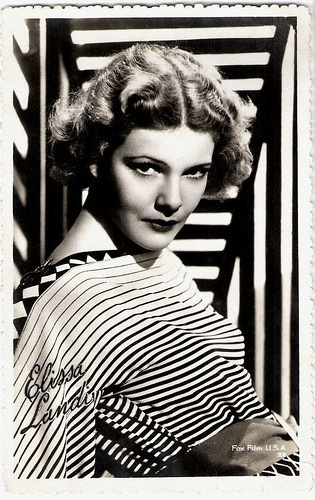
French postcard by Editions et Publications Cinématographiques, no. 21. Photo: Fox Film USA.
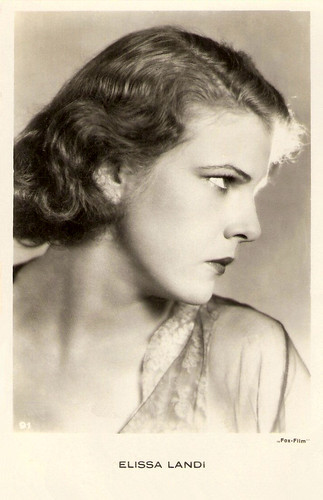
Dutch postcard, no. 92. Photo: Fox. Sent by mail in 1932.
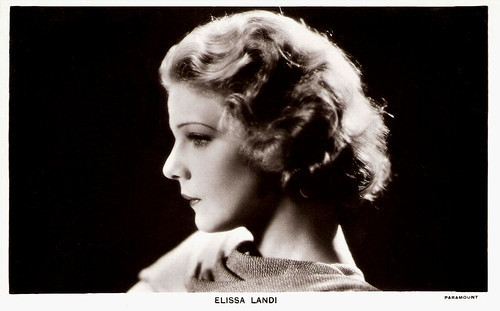
British postcard in the Picturegoer Series, London, no. 533b. Photo: Paramount.
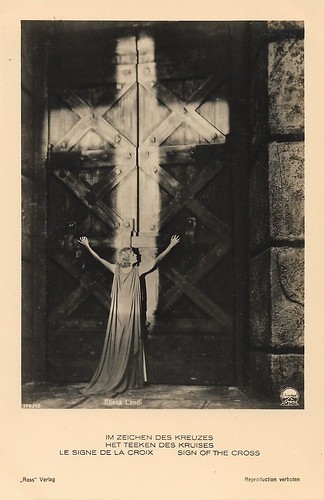
German postcard by Ross Verlag, no. 176/12. Photo: Paramount. Elissa Landi in the American epic The Sign of the Cross (Cecil B. DeMille, 1932), based on the original 1895 play by Wilson Barrett.
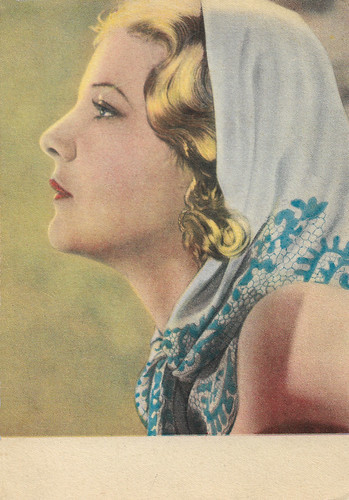
Italian postcard by NMM, Milano.
Photogenic Beauty
According to several sources, Elissa Landi was born as Elisabeth Marie Christine Kühnelt in Venice, Italy, in 1904. She was the daughter of an Austrian military officer and the stepdaughter of an Italian nobleman and she was a descendant of Elizabeth of Bavaria, wife of the Emperor Franz Josef of Austria and better known as Sissi, according to her mother in a book which she published in 1914.
This information was false. Marlene Pilaete at La Collectionneuse recently researched Landi's history and discovered new facts: "She was not Italian-born. In fact, her birth certificate states that she was born on the 6th of December 1904 in Hart, Austria and not in Venice. Her birth certificate also states that she was born as Maria Christina Emilia Antonia Carolina Francisca Anna Kühnelt. As you can see, there is no trace of the first name 'Elisabeth'. Regarding her mother, who claimed to be a daughter of Sissi and to be born in France in 1882, her birth certificate plainly states that she was born in Vienna in 1879 from Jewish parents."
Elissa was raised in Austria and later she was privately educated in England and Canada. Her first ambition was to be a writer, and she wrote her first novel at the age of twenty. She took up the stage merely as a means to an end. She had always wanted to be a novelist and playwright, but she found the technique of the theatre a little difficult, so in order to overcome this joined a repertory company.
She had her breakthrough with the 1924 London stage production 'The Storm'. The play lasted for five months and she received rave reviews for her performances. This led to meaty leads in 'Lavender Ladies' (1924) and other plays. Film producers took notice of the photogenic beauty and Elissa starred in eight European films over the next two years.
Her first film was the British production London (Herbert Wilcox, 1926), starring Dorothy Gish. Other films were the working-class love story Underground (Anthony Asquith, 1928) and the Swedish production Synd/Sin (Gustaf Molander, 1928) opposite Gina Manès . Her career didn't impress critics, though, until she played Anthea Dane in The Price of Things (Elinor Glyn, 1930).

French postcard by Editions Cinémagazine, no. 2063. Photo: Paramount. Fredric March and Elissa Landi in the American epic film The Sign of the Cross (Cecil B. DeMille, 1932).
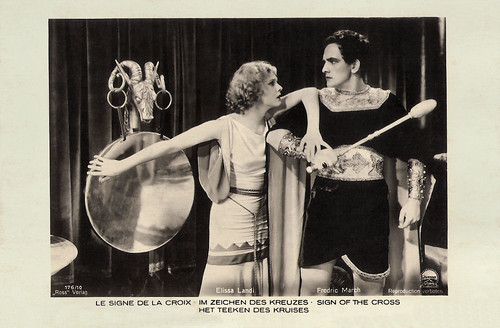
German postcard by Ross Verlag, no. 176/10. Photo: Paramount. Elissa Landi and Fredric March in The Sign of the Cross (Cecil B. DeMille, 1932).
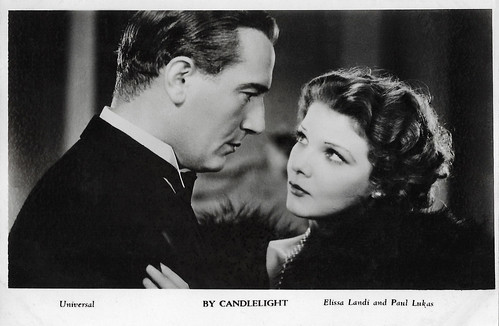
British postcard in the Film Shots series by Film Weekly. Photo: Universal. Paul Lukas and Elissa Landi in By Candlelight (James Whale, 1933).
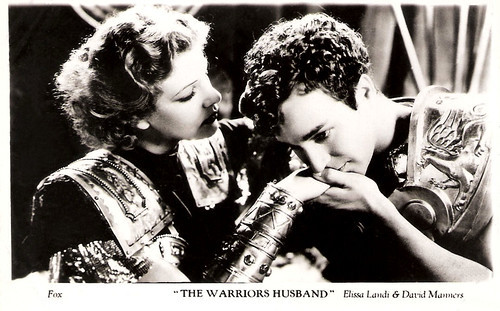
British postcard in the Filmshots series by Film Weekly. Photo: Fox. Publicity still for The Warrior's Husband (Walter Lang, 1933) with David Manners.
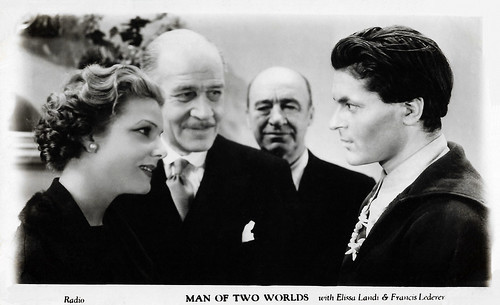
British postcard in the Film Shots series by Film Weekly. Photo: Radio (RKO). Elissa Landi, Henry Stephenson and Francis Lederer in Man of Two Worlds (J. Walter Ruben, 1934). In the background J. Farrell MacDonald.
Headway in the USA
Elissa Landi felt that she would make more headway in the USA, so in 1931 she travelled to New York to star in a Broadway production of 'A Farewell to Arms', written by Ernest Hemingway. Although the play flopped, Hollywood sat up and took notice of the young star. She was signed to a contract by Fox Film Corporation, and she soon appeared in Body and Soul (Alfred Santell, 1931) opposite Charles Farrell , and in Wicked (Alan Dwan, 1931), opposite Victor McLaglen .
Next, she played the heroine in Cecil B. De Mille's biblical epic The Sign of the Cross (1932). Elissa's ethereal, virtuous performance as the early-Christian heroine was overshadowed by Claudette Colbert who played the flashier role of the temptress Poppea. Completed in less than eight weeks, the film was a smash hit. Elissa scored again in the historical satire The Warrior's Husband (Walter Lang, 1933), about the intrigues and intricacies of the old Roman Empire.
Charming was her comedy By Candlelight (James Whale, 1933) about a butler ( Paul Lukas ) who pretends to be a Lord to seduce a great lady (Landi), who is actually a maid. Hal Erickson writes at AllMovie : "Based on a play by Siegfried Geyer, By Candlelight is chock full of delightfully double-entendre pre-Code dialogue and dextrous directorial touches."
In 1934, Landi co-starred with Robert Donat in the box office hit The Count of Monte Cristo (Rowland V. Lee, 1934). The next year saw her in an odd bit of casting as an Opera prima donna in Enter Madame (Elliott Nugent, 1935). The film follows the turbulent relationship between the Opera singer and a wealthy fan ( Cary Grant ) as her career frequently interferes with the quality of their off-again/on-again marriage.
Then Landi's contract with Fox was abruptly cancelled in 1936 as a result of her refusal to accept a particular role. MGM signed her to a contract and after a couple of romantic dramas, she played the cousin of Myrna Loy in the very popular After the Thin Man (W.S. Van Dyke, 1936), the second film in the Thin Man series.
Her screen career came to an end in 1937. She spent her last acting years on Broadway save for an unexpected return before the cameras in the low-budget war film Corregidor (William Nigh, 1943) for Poverty Row Producers Releasing Corporation (PRC). She became a naturalised US citizen in 1943, and dedicated herself to writing, producing six novels and a series of poems. After her debut at the age of twenty, she had continued writing novels at the height of her movie fame.
In 1948, Elissa Landi died of cancer in Kingston, New York, only 43 years old, and was buried at Oak Hill Cemetery in Newburyport, Massachusetts. She left behind her second husband, Curtiss Thomas, and their four-year-old daughter, Carolyn. Her first marriage was to John Cecil Lawrence (1928-1936; divorce). Elissa Landi has a star on the Hollywood Walk of Fame for her contributions to Motion Pictures, at 1611 Vine Street.
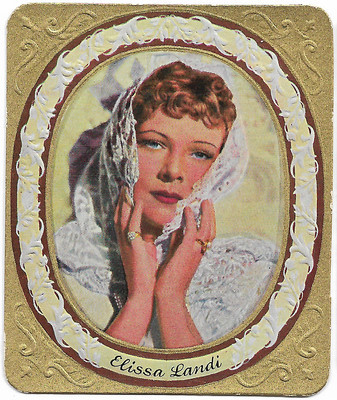
German collectors card in the 'Moderne Schönheitsgalerie' by Ross Verlag for Edelzigarette Kurmark, no 292 (of 300). Photo: Paramount.
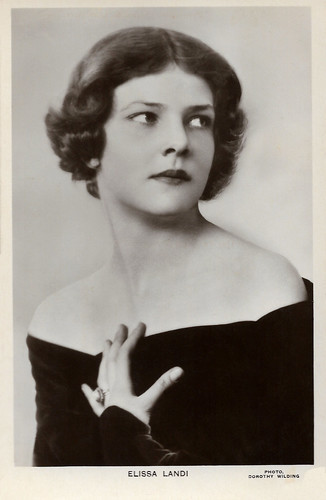
British postcard in the Picturegoer Series, London, no. 533. Photo: Dorothy Wilding.
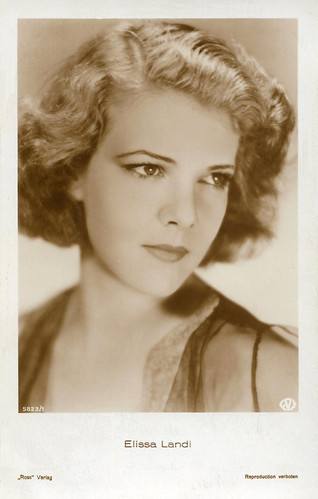
German postcard by Ross Verlag, no. 5823/1, 1930-1931. Photo: Fox.
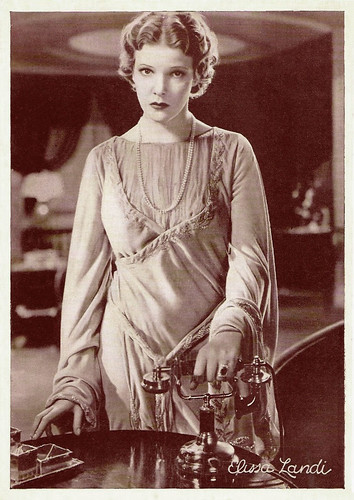
Dutch postcard. Sent by mail in 1934.
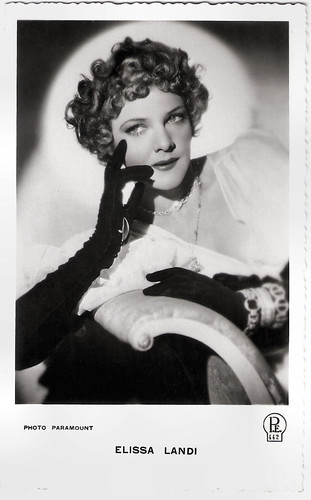
Belgian postcard by P.E. (Photo Edition), Brussels, no. 442. Photo: Paramount.
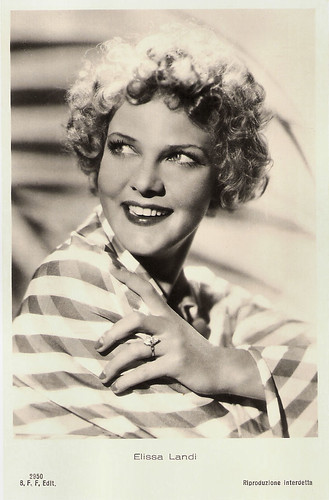
Italian postcard by B.F.F. Edit. (Casa Editr. Ballerini & Fratini, Firenze), no. 2950.
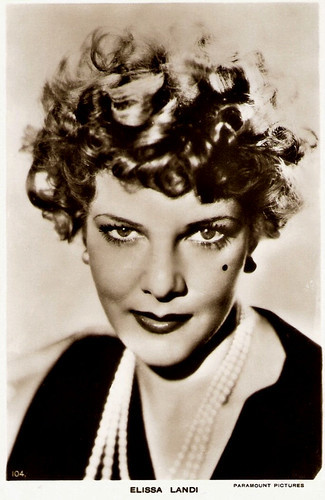
British postcard by Milton, no. 104. Photo: Paramount Pictures.
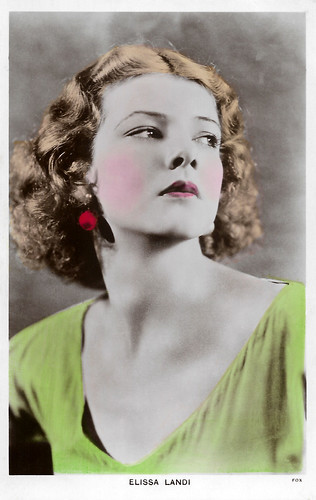
British postcard in the Colourgraph Series, London, no. C 185. Photo: Fox.
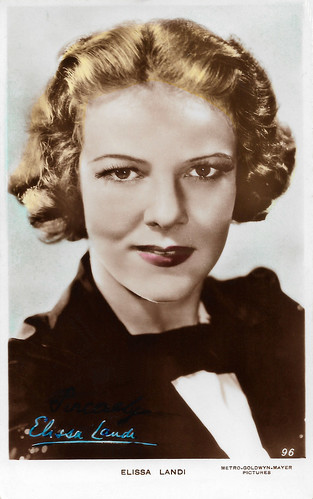
British postcard by Art Photo, no. 96. Photo: Metro-Goldwyn-Mayer Pictures.
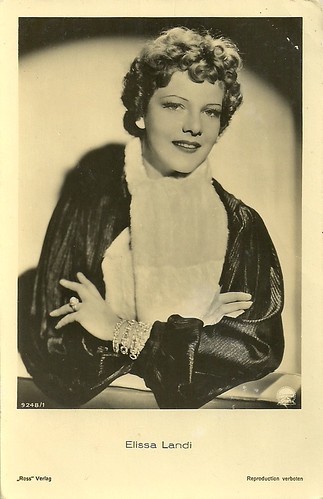
German postcard by Ross Verlag, no. 9248/1, 1935-1936. Photo: Metro-Goldwyn-Mayer.
Clark Gable, Elisa Landi and Joan Bennett in the short Hollywood Party (1937). Source: Cinecinéfilos Bio dos (YouTube).
Sources: Marlene Pilaete (La Collectionneuse - French), (IMDb), Operator99 (Allure), Hal Erickson (AllMovie), Wikipedia, and .

French postcard by Editions et Publications Cinématographiques, no. 21. Photo: Fox Film USA.

Dutch postcard, no. 92. Photo: Fox. Sent by mail in 1932.

British postcard in the Picturegoer Series, London, no. 533b. Photo: Paramount.

German postcard by Ross Verlag, no. 176/12. Photo: Paramount. Elissa Landi in the American epic The Sign of the Cross (Cecil B. DeMille, 1932), based on the original 1895 play by Wilson Barrett.

Italian postcard by NMM, Milano.
Photogenic Beauty
According to several sources, Elissa Landi was born as Elisabeth Marie Christine Kühnelt in Venice, Italy, in 1904. She was the daughter of an Austrian military officer and the stepdaughter of an Italian nobleman and she was a descendant of Elizabeth of Bavaria, wife of the Emperor Franz Josef of Austria and better known as Sissi, according to her mother in a book which she published in 1914.
This information was false. Marlene Pilaete at La Collectionneuse recently researched Landi's history and discovered new facts: "She was not Italian-born. In fact, her birth certificate states that she was born on the 6th of December 1904 in Hart, Austria and not in Venice. Her birth certificate also states that she was born as Maria Christina Emilia Antonia Carolina Francisca Anna Kühnelt. As you can see, there is no trace of the first name 'Elisabeth'. Regarding her mother, who claimed to be a daughter of Sissi and to be born in France in 1882, her birth certificate plainly states that she was born in Vienna in 1879 from Jewish parents."
Elissa was raised in Austria and later she was privately educated in England and Canada. Her first ambition was to be a writer, and she wrote her first novel at the age of twenty. She took up the stage merely as a means to an end. She had always wanted to be a novelist and playwright, but she found the technique of the theatre a little difficult, so in order to overcome this joined a repertory company.
She had her breakthrough with the 1924 London stage production 'The Storm'. The play lasted for five months and she received rave reviews for her performances. This led to meaty leads in 'Lavender Ladies' (1924) and other plays. Film producers took notice of the photogenic beauty and Elissa starred in eight European films over the next two years.
Her first film was the British production London (Herbert Wilcox, 1926), starring Dorothy Gish. Other films were the working-class love story Underground (Anthony Asquith, 1928) and the Swedish production Synd/Sin (Gustaf Molander, 1928) opposite Gina Manès . Her career didn't impress critics, though, until she played Anthea Dane in The Price of Things (Elinor Glyn, 1930).

French postcard by Editions Cinémagazine, no. 2063. Photo: Paramount. Fredric March and Elissa Landi in the American epic film The Sign of the Cross (Cecil B. DeMille, 1932).

German postcard by Ross Verlag, no. 176/10. Photo: Paramount. Elissa Landi and Fredric March in The Sign of the Cross (Cecil B. DeMille, 1932).

British postcard in the Film Shots series by Film Weekly. Photo: Universal. Paul Lukas and Elissa Landi in By Candlelight (James Whale, 1933).

British postcard in the Filmshots series by Film Weekly. Photo: Fox. Publicity still for The Warrior's Husband (Walter Lang, 1933) with David Manners.

British postcard in the Film Shots series by Film Weekly. Photo: Radio (RKO). Elissa Landi, Henry Stephenson and Francis Lederer in Man of Two Worlds (J. Walter Ruben, 1934). In the background J. Farrell MacDonald.
Headway in the USA
Elissa Landi felt that she would make more headway in the USA, so in 1931 she travelled to New York to star in a Broadway production of 'A Farewell to Arms', written by Ernest Hemingway. Although the play flopped, Hollywood sat up and took notice of the young star. She was signed to a contract by Fox Film Corporation, and she soon appeared in Body and Soul (Alfred Santell, 1931) opposite Charles Farrell , and in Wicked (Alan Dwan, 1931), opposite Victor McLaglen .
Next, she played the heroine in Cecil B. De Mille's biblical epic The Sign of the Cross (1932). Elissa's ethereal, virtuous performance as the early-Christian heroine was overshadowed by Claudette Colbert who played the flashier role of the temptress Poppea. Completed in less than eight weeks, the film was a smash hit. Elissa scored again in the historical satire The Warrior's Husband (Walter Lang, 1933), about the intrigues and intricacies of the old Roman Empire.
Charming was her comedy By Candlelight (James Whale, 1933) about a butler ( Paul Lukas ) who pretends to be a Lord to seduce a great lady (Landi), who is actually a maid. Hal Erickson writes at AllMovie : "Based on a play by Siegfried Geyer, By Candlelight is chock full of delightfully double-entendre pre-Code dialogue and dextrous directorial touches."
In 1934, Landi co-starred with Robert Donat in the box office hit The Count of Monte Cristo (Rowland V. Lee, 1934). The next year saw her in an odd bit of casting as an Opera prima donna in Enter Madame (Elliott Nugent, 1935). The film follows the turbulent relationship between the Opera singer and a wealthy fan ( Cary Grant ) as her career frequently interferes with the quality of their off-again/on-again marriage.
Then Landi's contract with Fox was abruptly cancelled in 1936 as a result of her refusal to accept a particular role. MGM signed her to a contract and after a couple of romantic dramas, she played the cousin of Myrna Loy in the very popular After the Thin Man (W.S. Van Dyke, 1936), the second film in the Thin Man series.
Her screen career came to an end in 1937. She spent her last acting years on Broadway save for an unexpected return before the cameras in the low-budget war film Corregidor (William Nigh, 1943) for Poverty Row Producers Releasing Corporation (PRC). She became a naturalised US citizen in 1943, and dedicated herself to writing, producing six novels and a series of poems. After her debut at the age of twenty, she had continued writing novels at the height of her movie fame.
In 1948, Elissa Landi died of cancer in Kingston, New York, only 43 years old, and was buried at Oak Hill Cemetery in Newburyport, Massachusetts. She left behind her second husband, Curtiss Thomas, and their four-year-old daughter, Carolyn. Her first marriage was to John Cecil Lawrence (1928-1936; divorce). Elissa Landi has a star on the Hollywood Walk of Fame for her contributions to Motion Pictures, at 1611 Vine Street.

German collectors card in the 'Moderne Schönheitsgalerie' by Ross Verlag for Edelzigarette Kurmark, no 292 (of 300). Photo: Paramount.

British postcard in the Picturegoer Series, London, no. 533. Photo: Dorothy Wilding.

German postcard by Ross Verlag, no. 5823/1, 1930-1931. Photo: Fox.

Dutch postcard. Sent by mail in 1934.

Belgian postcard by P.E. (Photo Edition), Brussels, no. 442. Photo: Paramount.

Italian postcard by B.F.F. Edit. (Casa Editr. Ballerini & Fratini, Firenze), no. 2950.

British postcard by Milton, no. 104. Photo: Paramount Pictures.

British postcard in the Colourgraph Series, London, no. C 185. Photo: Fox.

British postcard by Art Photo, no. 96. Photo: Metro-Goldwyn-Mayer Pictures.

German postcard by Ross Verlag, no. 9248/1, 1935-1936. Photo: Metro-Goldwyn-Mayer.
Clark Gable, Elisa Landi and Joan Bennett in the short Hollywood Party (1937). Source: Cinecinéfilos Bio dos (YouTube).
Sources: Marlene Pilaete (La Collectionneuse - French), (IMDb), Operator99 (Allure), Hal Erickson (AllMovie), Wikipedia, and .
Published on April 05, 2020 22:00
April 4, 2020
New Acquisitions: Vom Werden deutscher Filmkunst - Der Tonfilm: Part 4
Today the final part of the series 'Vom Werden deutscher Filmkunst - Der Tonfilm' (From the becoming of German film art, the sound film) by Ross Verlag. The collectors cards treat the German sound film between 1929 and 1935. Today the final part, which illustrates the wave of propaganda films after the rise of the Nazis. The numbers 151-200 include some cards from rarely seen Nazi propaganda from the years 1933 and 1934.
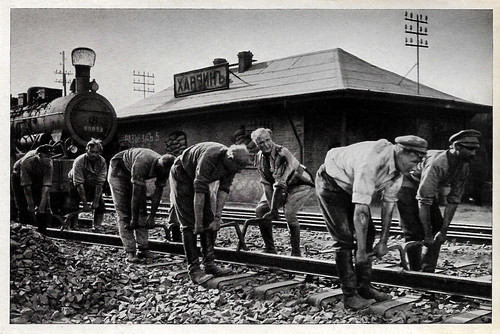
German collectors card in the series 'Vom Werden deutscher Filmkunst - Der Tonfilm', album no. 11, picture no. 155. Photo: Ufa / Ross Verlag. Hans Albers in Flüchtlinge/Fugitives (Gustav Ucicky, 1933).
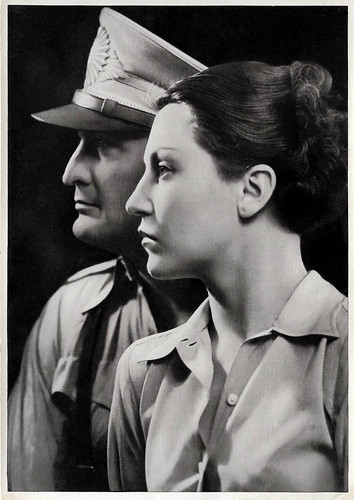
German collectors card in the series 'Vom Werden deutscher Filmkunst - Der Tonfilm', album no. 11, picture no. 156. Photo: Ufa / Ross Verlag. Hans Albers and Käthe von Nagy in Flüchtlinge/Fugitives (Gustav Ucicky, 1933).

German collectors card in the series 'Vom Werden deutscher Filmkunst - Der Tonfilm', album no. 11, picture no. 162. Photo: Europa / Ross Verlag. Mathias Wieman in Der Schimmelreiter/The Rider of the White Horse (Hans Deppe, Curt Oertel, 1934).

German collectors card in the series 'Vom Werden deutscher Filmkunst - Der Tonfilm', album no. 11, picture no. 167. Photo: Froelich-Film / Ross Verlag. Wilhelm P. Krüger in Krach um Jolanthe/Noisy Jolanthe (Carl Froelich, 1934).
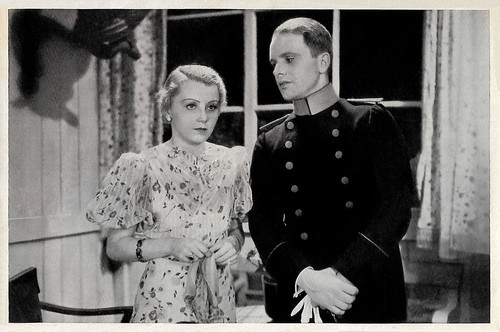
German collectors card in the series 'Vom Werden deutscher Filmkunst - Der Tonfilm', album no. 11, image no. 169, Group 44. Photo: Bayerische Filmges. / Ross Verlag. Reva Holsey and Fritz Genschow in Die spork'schen Jäger/The Sporck Battalion (Rolf Randolf, Theodor Loos, 1934)

German collectors card in the series 'Vom Werden deutscher Filmkunst - Der Tonfilm', album no. 11, picture no. 175. Photo: Bavaria-Tofa / Ross Verlag. Marieluise Claudius and Hans Albers in Peer Gynt (Fritz Wendhausen, 1934).
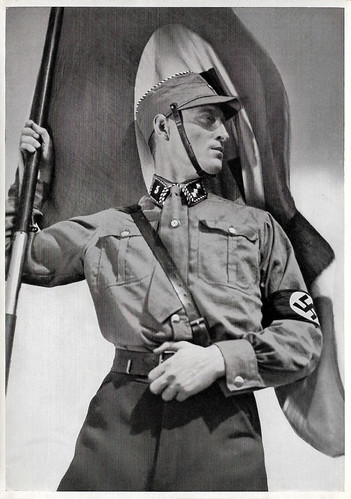
German collectors card in the series 'Vom Werden deutscher Filmkunst - Der Tonfilm', album no. 11, picture no. 180. Photo: Volksdeutsche Filmges. / Ross Verlag. Emil Lohkamp in Hans Westmar (Franz Wenzler, 1933).
Hans Westmar (Franz Wenzler, 1933) is a Nazi propaganda film, which purports to show the story of a Nazi Storm Trooper named Horst Wessel - here called 'Hans Westmar'. At age 21, Wessel led the SA unit in Friedrichshain, Berlin's toughest slum and the reddest district in the 'Red City'. He recruited from the Communists, with considerable success. He took part in street brawls and assassinations in Berlin in the 1920s and 1930s against Communists and other opponents of the Nazis. He was killed by Communists not long before this film came out. The film contains period footage of streetscapes, SA marches and very good representations of the street battles (Strassenkämpfe) between Nazi and Communist militias in Berlin in the late 1920s.
Emil Lohkamp plays the title character with freneticism, probably an accurate portrayal as Wessel virtually wore himself out leading his Sturm. Wessel was assassinated by communists in January 1930. This film was made a few months after the takeover, when the victorious SA had served its purpose. Its hard drinking, hard partying henchmen were unruly, undisciplined, and uncontrollable. As history told by the victors, it recounts mostly real events, altered to fit the 'official truth'. Brownshirts picking fights didn't fit the image the Nazi party wanted to project once in power. The film saw only limited release. Any interest lies in how the Nazis recast history and in a few unique scenes.
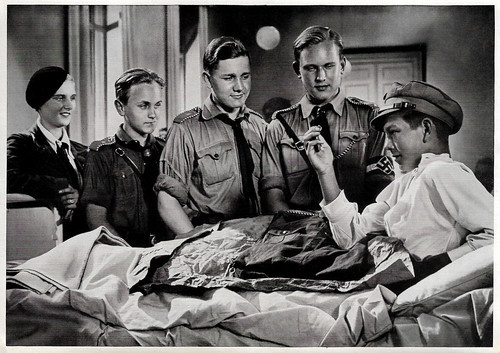
German collectors card in the series 'Vom Werden deutscher Filmkunst - Der Tonfilm', album no. 11, picture no. 184. Photo: Ufa / Ross Verlag. Jürgen Ohlsen in Hitlerjunge Quex/Hitler Youth Quex (Hans Steinhoff, 1933).
Hitlerjunge Quex: Ein Film vom Opfergeist der deutschen Jugend/Hitler Youth Quex (1933) is a German film directed by Hans Steinhoff, based on the 1932 novel 'Hitler Youth Quex' (Hitlerjunge Quex). The film was shown in the US under the title Our Flag Leads Us Forward. Hitlerjunge Quex/Hitler Youth Quex (Hans Steinhoff, 1933) was produced in the Universum Film AG (Ufa) studios. The plot was written by Bobby E. Lüthge and Karl Aloys Schenzinger, the author of the novel. Produced by Karl Ritter, it was supported by the Nazi leadership and produced for 320,000 reichsmarks (equivalent to €1,257,146 in 2009) under the aegis of Baldur von Schirach. The latter also wrote the lyrics for the Hitler Youth marching song 'Vorwärts! Vorwärts! schmettern die hellen Fanfaren', better known by its refrain, 'Unsere Fahne flattert uns voran', using an existing melody by Hans-Otto Borgmann, who was also responsible for the music.
The director was Hans Steinhoff. For the film, the subtitle 'Ein Film vom Opfergeist der deutschen Jugend' (A film about the sacrificial spirit of German youth) was added to the novel's title. The film premiered on 11 September 1933 at the Ufa-Phoebus Palace in Munich, and on 19 September at the Ufa-Palast am Zoo in Berlin. It was one of three films about Nazi martyrs in 1933, the other two being SA-Mann Brand and Hans Westmar. The film's producer, Karl Ritter, recalled in his private diaries the famous scene where Vater Völker ( Heinrich George ) slaps his son (Jürgen Ohlsen) violently after he overhears him singing the HJ song 'Unsere Fahne flattert uns voran. The diary entry: Unforgettable was the George–Jürgen Ohlsen ear–slapping scene. George first paid for Jürgen’s ice cream and took him into the canteen like a godfather would. Jürgen saw nothing to fear in him. So then, when the dreadful ear–slap scene came, the tears shot from his eyes.
The film premiered in the United States at the Yorkville Theatre on the Upper East Side of Manhattan on 6 July 1934 as Our Flag Leads Us Forward and in March 1942 in Paris as Le jeune hitlérien. Adolf Hitler, Rudolf Hess, Joseph Goebbels and other high Nazi functionaries attended the first premiere in Munich. Goebbels reflected on the film as follows: "If Hitler Youth Quex represents the first large-scale attempt to depict the ideas and world of National Socialism with the art of cinema, then one must say that this attempt, given the possibilities of modern technology, is a full-fledged success." By January 1934 it had been viewed by a million people. Hitlerjunge Quex is now classified in Germany as a 'Vorbehaltsfilm' (conditional film), meaning it is illegal to show it outside of closed educational events guided by an expert.
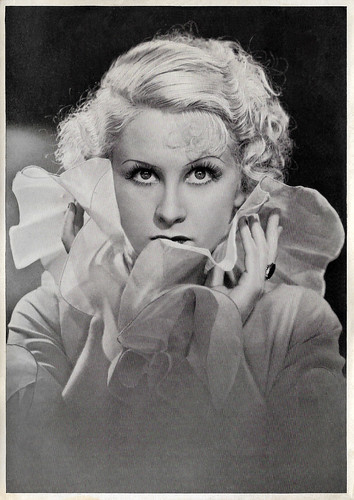
German collectors card in the series 'Vom Werden deutscher Filmkunst - Der Tonfilm', album no. 11, picture no. 194. Photo: Ufa / Ross Verlag. Austrian actress and singer Dorit Kreysler (1909-1999) appeared in German and Austrian comedies and musicals of the 1930s, 1940s and 1950s.
Source: IMDb and Wikipedia.

German collectors card in the series 'Vom Werden deutscher Filmkunst - Der Tonfilm', album no. 11, picture no. 155. Photo: Ufa / Ross Verlag. Hans Albers in Flüchtlinge/Fugitives (Gustav Ucicky, 1933).

German collectors card in the series 'Vom Werden deutscher Filmkunst - Der Tonfilm', album no. 11, picture no. 156. Photo: Ufa / Ross Verlag. Hans Albers and Käthe von Nagy in Flüchtlinge/Fugitives (Gustav Ucicky, 1933).

German collectors card in the series 'Vom Werden deutscher Filmkunst - Der Tonfilm', album no. 11, picture no. 162. Photo: Europa / Ross Verlag. Mathias Wieman in Der Schimmelreiter/The Rider of the White Horse (Hans Deppe, Curt Oertel, 1934).

German collectors card in the series 'Vom Werden deutscher Filmkunst - Der Tonfilm', album no. 11, picture no. 167. Photo: Froelich-Film / Ross Verlag. Wilhelm P. Krüger in Krach um Jolanthe/Noisy Jolanthe (Carl Froelich, 1934).

German collectors card in the series 'Vom Werden deutscher Filmkunst - Der Tonfilm', album no. 11, image no. 169, Group 44. Photo: Bayerische Filmges. / Ross Verlag. Reva Holsey and Fritz Genschow in Die spork'schen Jäger/The Sporck Battalion (Rolf Randolf, Theodor Loos, 1934)

German collectors card in the series 'Vom Werden deutscher Filmkunst - Der Tonfilm', album no. 11, picture no. 175. Photo: Bavaria-Tofa / Ross Verlag. Marieluise Claudius and Hans Albers in Peer Gynt (Fritz Wendhausen, 1934).

German collectors card in the series 'Vom Werden deutscher Filmkunst - Der Tonfilm', album no. 11, picture no. 180. Photo: Volksdeutsche Filmges. / Ross Verlag. Emil Lohkamp in Hans Westmar (Franz Wenzler, 1933).
Hans Westmar (Franz Wenzler, 1933) is a Nazi propaganda film, which purports to show the story of a Nazi Storm Trooper named Horst Wessel - here called 'Hans Westmar'. At age 21, Wessel led the SA unit in Friedrichshain, Berlin's toughest slum and the reddest district in the 'Red City'. He recruited from the Communists, with considerable success. He took part in street brawls and assassinations in Berlin in the 1920s and 1930s against Communists and other opponents of the Nazis. He was killed by Communists not long before this film came out. The film contains period footage of streetscapes, SA marches and very good representations of the street battles (Strassenkämpfe) between Nazi and Communist militias in Berlin in the late 1920s.
Emil Lohkamp plays the title character with freneticism, probably an accurate portrayal as Wessel virtually wore himself out leading his Sturm. Wessel was assassinated by communists in January 1930. This film was made a few months after the takeover, when the victorious SA had served its purpose. Its hard drinking, hard partying henchmen were unruly, undisciplined, and uncontrollable. As history told by the victors, it recounts mostly real events, altered to fit the 'official truth'. Brownshirts picking fights didn't fit the image the Nazi party wanted to project once in power. The film saw only limited release. Any interest lies in how the Nazis recast history and in a few unique scenes.

German collectors card in the series 'Vom Werden deutscher Filmkunst - Der Tonfilm', album no. 11, picture no. 184. Photo: Ufa / Ross Verlag. Jürgen Ohlsen in Hitlerjunge Quex/Hitler Youth Quex (Hans Steinhoff, 1933).
Hitlerjunge Quex: Ein Film vom Opfergeist der deutschen Jugend/Hitler Youth Quex (1933) is a German film directed by Hans Steinhoff, based on the 1932 novel 'Hitler Youth Quex' (Hitlerjunge Quex). The film was shown in the US under the title Our Flag Leads Us Forward. Hitlerjunge Quex/Hitler Youth Quex (Hans Steinhoff, 1933) was produced in the Universum Film AG (Ufa) studios. The plot was written by Bobby E. Lüthge and Karl Aloys Schenzinger, the author of the novel. Produced by Karl Ritter, it was supported by the Nazi leadership and produced for 320,000 reichsmarks (equivalent to €1,257,146 in 2009) under the aegis of Baldur von Schirach. The latter also wrote the lyrics for the Hitler Youth marching song 'Vorwärts! Vorwärts! schmettern die hellen Fanfaren', better known by its refrain, 'Unsere Fahne flattert uns voran', using an existing melody by Hans-Otto Borgmann, who was also responsible for the music.
The director was Hans Steinhoff. For the film, the subtitle 'Ein Film vom Opfergeist der deutschen Jugend' (A film about the sacrificial spirit of German youth) was added to the novel's title. The film premiered on 11 September 1933 at the Ufa-Phoebus Palace in Munich, and on 19 September at the Ufa-Palast am Zoo in Berlin. It was one of three films about Nazi martyrs in 1933, the other two being SA-Mann Brand and Hans Westmar. The film's producer, Karl Ritter, recalled in his private diaries the famous scene where Vater Völker ( Heinrich George ) slaps his son (Jürgen Ohlsen) violently after he overhears him singing the HJ song 'Unsere Fahne flattert uns voran. The diary entry: Unforgettable was the George–Jürgen Ohlsen ear–slapping scene. George first paid for Jürgen’s ice cream and took him into the canteen like a godfather would. Jürgen saw nothing to fear in him. So then, when the dreadful ear–slap scene came, the tears shot from his eyes.
The film premiered in the United States at the Yorkville Theatre on the Upper East Side of Manhattan on 6 July 1934 as Our Flag Leads Us Forward and in March 1942 in Paris as Le jeune hitlérien. Adolf Hitler, Rudolf Hess, Joseph Goebbels and other high Nazi functionaries attended the first premiere in Munich. Goebbels reflected on the film as follows: "If Hitler Youth Quex represents the first large-scale attempt to depict the ideas and world of National Socialism with the art of cinema, then one must say that this attempt, given the possibilities of modern technology, is a full-fledged success." By January 1934 it had been viewed by a million people. Hitlerjunge Quex is now classified in Germany as a 'Vorbehaltsfilm' (conditional film), meaning it is illegal to show it outside of closed educational events guided by an expert.

German collectors card in the series 'Vom Werden deutscher Filmkunst - Der Tonfilm', album no. 11, picture no. 194. Photo: Ufa / Ross Verlag. Austrian actress and singer Dorit Kreysler (1909-1999) appeared in German and Austrian comedies and musicals of the 1930s, 1940s and 1950s.
Source: IMDb and Wikipedia.
Published on April 04, 2020 22:00
April 3, 2020
What we've found lately
Lately, we bought a lot of interesting postcards and collectors cards. They are quite different from each other. So for today a very diverse post at EFSP with 30 cards we recently acquired. Hope you enjoy it.
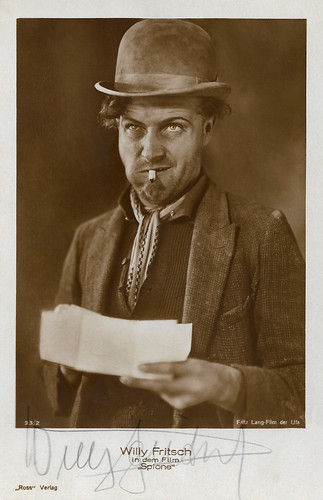
German postcard by Ross Verlag, no. 33/2. Photo: Fritz Lang-Film / Ufa. Willy Fritsch in Spione/Spies (Fritz Lang, 1928).
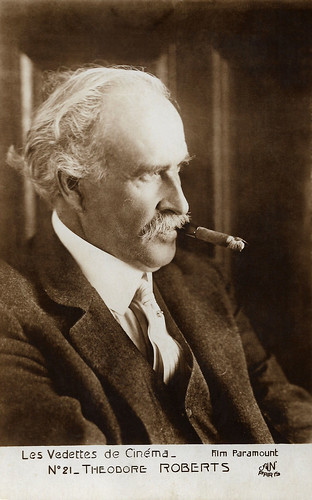
French postcard in the Les Vedettes de Cinéma serie by A.N., Paris, no. 21. Photo: Paramount.
Theodore Roberts (1861-1928) was an American stage and screen actor, who is known for his many parts in films by Cecil B. DeMille and his brother William.
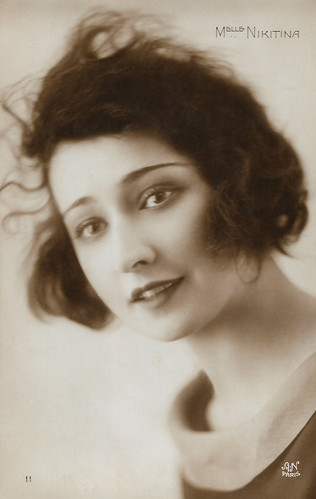
French postcard by A.N., Paris, no. 11.
Alice Nikitina (1904-1978) was a Russian dancer, teacher, and opera singer. She appeared in two films, The Blue Danube (1932) and Ma femme... homme d'affaires/My Wife as a Businessman (1932).
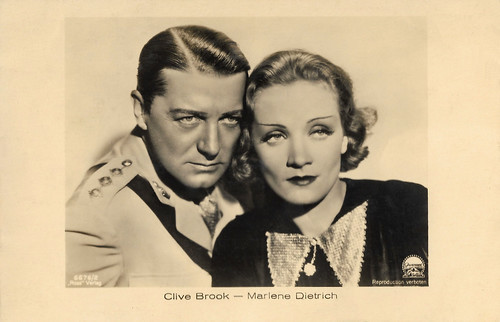
German postcard by Ross Verlag, no. 6676/2. Photo: Paramount. Marlene Dietrich as Shanghai Lily and Clive Brook as 'Doc' Harvey in Shanghai Express (Josef von Sternberg, 1932).
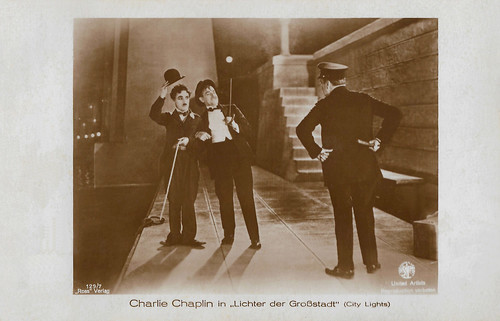
German postcard by Ross Verlag, no. 129/7. Photo: United Artists. Charlie Chaplin and Harry Myers in City Lights (Charles Chaplin, 1931).
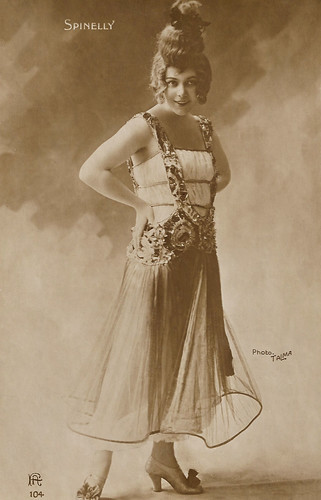
French postcard by FA, no. 104. Photo: Talma.
French actress Andrée Spinelly (1887-1966) was commonly known as Spinelly. Her charm was celebrated by critics. During the 1930s, Spinelly starred in a few films.
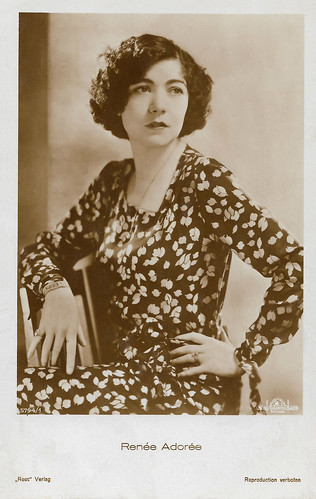
German postcard by Ross Verlag, no. 5794/1, 1930-1931. Photo: Metro-Goldwyn-Mayer.
French actress Renée Adorée (1898-1933) appeared in Hollywood in several silent films during the 1920s. She is best known as Melisande in the successful war epic The Big Parade (King Vidor, 1925) opposite John Gilbert . She died a few days after her 35th birthday.
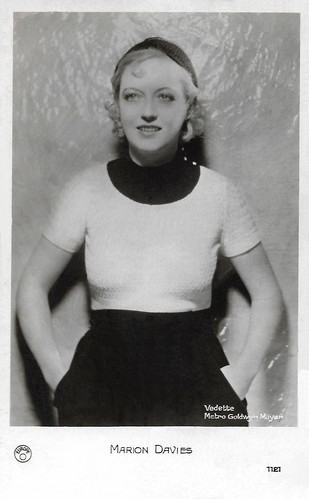
French postcard by Europe, no. 1121. Photo: MGM.
Marion Davies (1897-1961) was one of the great comedic actresses of the silent era. She starred in nearly four dozen films between 1917 and 1937.
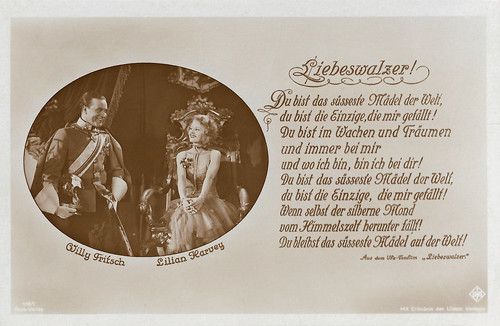
German postcard by Ross Verlag, no. 119/1. Photo: Ufa. Willy Fritsch and Lilian Harvey in Liebeswalzer/Love Waltz (Wilhelm Thiele, 1930).
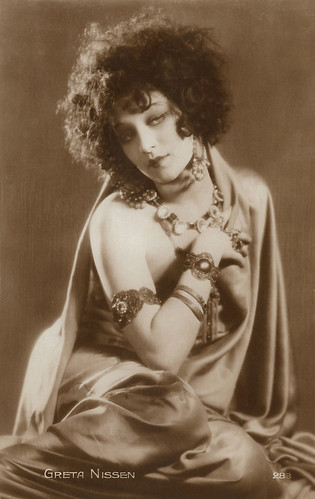
French postcard by Cinémagazine-Edition, Paris, no. 283. Photo: Paramount. Greta Nissen in The Wanderer (Raoul Walsh, 1925).
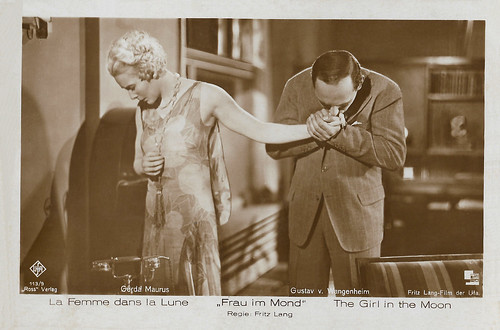
German postcard by Ross Verlag, no. 113/9. Photo: Ufa. Gerda Maurus and Gustav von Wangenheim in Frau im Mond/Woman in the Moon (Fritz Lang, 1929).

German postcard by Ross Verlag, no. 4329/1, 1929-1930. Photo: Paramount. Esther Ralston in The Case of Lena Smith (Josef von Sternberg, 1929).
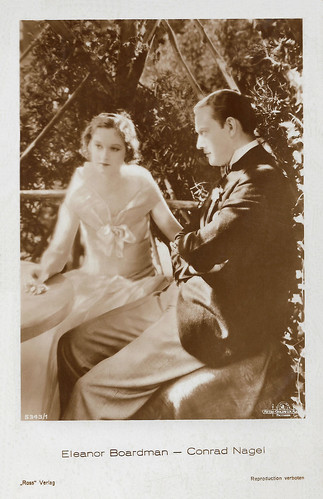
German postcard by Ross Verlag, no. 5343/1, 1930-1931. Photo: MGM. Eleanor Boardman and Conrad Nagel in The Only Thing (1925).
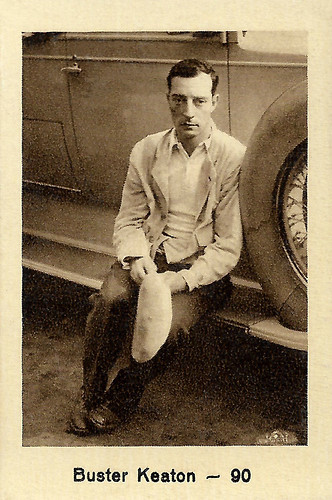
German cigarette card by Monopol Film-Bilder, no. 90.
Stone-faced Buster Keaton (1895-1966) was one of the three greatest comedians of Silent Hollywood.
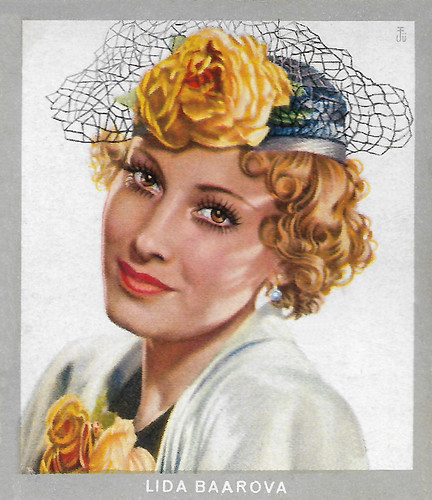
German cigarette card by Ross Verlag in the 'Künstler im Film' series for Zigarettenfabrik Monopol, Dresden, Serie 1, image 1. Photo: Ufa.
Beautiful Lída Baarová (1914-2000) was a glamorous Czech film star who worked in Prague, Berlin and Rome. A dangerous affair with Joseph Goebbels, the propaganda minister of the Third Reich, first enhanced and later seriously damaged her career.
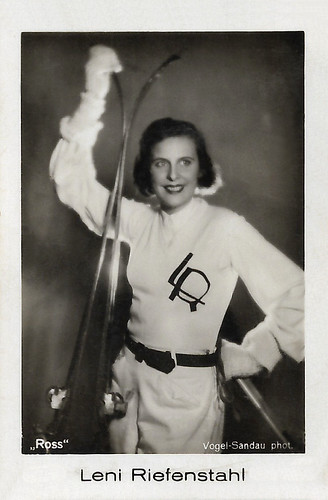
German cigarette card by Ross Verlag in the Ramses Film-Fotos series for Jasmatzi Cigarettenfabrik, Dresden. Serie 1, Image no. 145. Photo: Vogel-Sandau.
Leni Riefenstahl (1902-2003) was the notorious director of Triumph des Willens (1935), a fascinating propaganda documentary about Adolf Hitler and the Third Reich, commissioned by the Nazi government. Before she started directing films, she worked as a dancer and on screen she became a star in the mountain films, directed by Arnold Fanck.
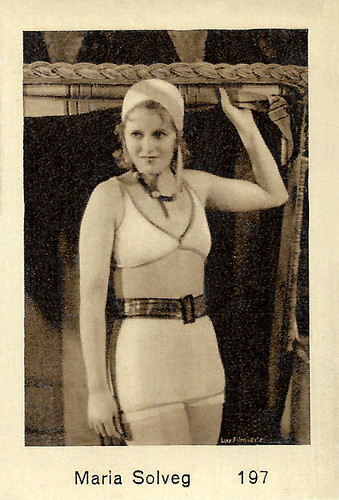
German cigarette card by Cigarettenfabrik Monopol, Dresden, no. 197. Photo: Lux Film Verl.
German film and screenwriter Maria Solveg or Maria Matray (1907–1993) was a star of the late Weimar cinema. When Hitler came to power, the Jewish actress went in exile and had a new career in the US as a choreographer and writer.
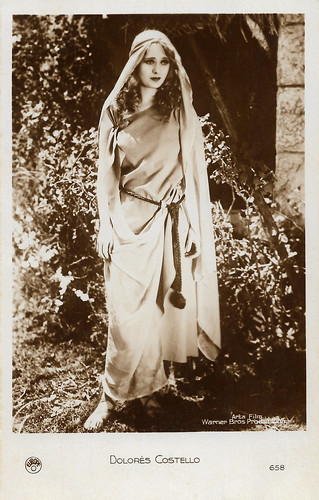
French postcard by Europe, no. 658. Photo: Warner Bros / Arta Film. Dolores Costello in Noah's Ark (Michael Curtiz, 1929).
American film actress Dolores Costello (1903-1979) was 'The Goddess of the Silent Screen'. She was Hollywood royalty: the daughter of popular matinee idol Maurice Costello, wife of John Barrymore and grandmother of Drew Barrymore.
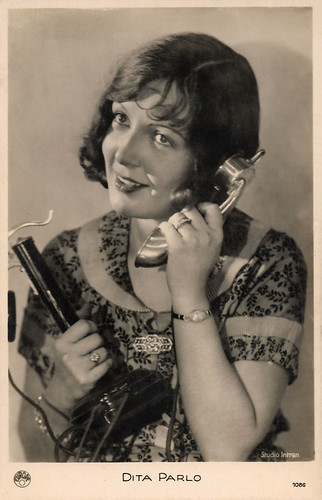
French postcard by Europe, no. 1086. Photo: Studio Intran.
Lovely Dita Parlo (1906-1971) was a star of German and French films of the late 1920s and 1930s, who also worked in Hollywood. She inspired both Dita Von Teese and Madonna, the latter used her name and character from L'Atalante (1934) for her Sex book and Erotica album.
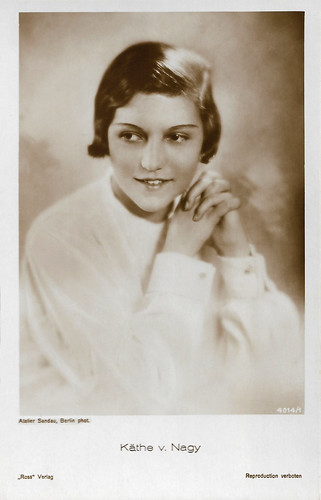
German postcard by Ross Verlag, no. 4014/1, 1929-1930. Photo: Atelier Sandau, Berlin.
Hungarian actress Käthe von Nagy (1904-1973) started as the ‘Backfish’ of German films of the late 1920s. In the early 1930s she became a fashionable and charming star of the German and French cinema.
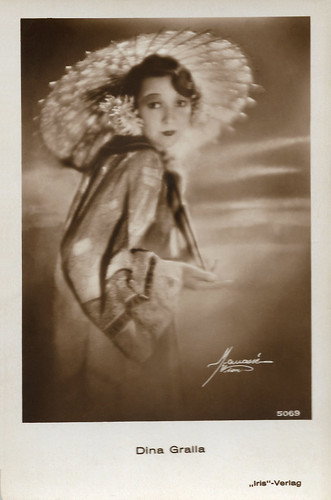
Austrian postcard by Iris-Verlag, no. 5069. Photo: Manassé, Wien.
Polish born, German actress Dina Gralla (1905-1994) often appeared as a naive, sexy dancer in German revues, and in more than 35 silent and early sound films.
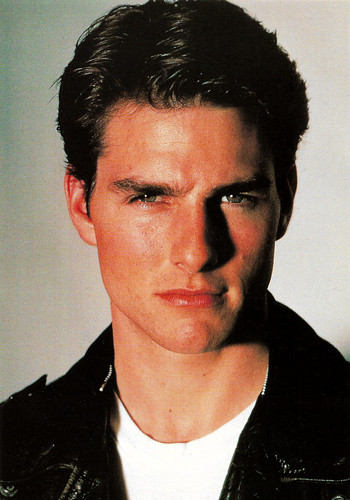
British postcard by Heroes Publishing Ltd., London, no. SPC 2894.
American actor and producer Tom Cruise (1962) became with his charismatic smile the most successful member of Hollywood's Brat Pack, the golden boys and girls of the 1980s. Top Gun (1985) made him an action star, but with his roles in The Color of Money (1986), Rain Man (1988) and Born on the Fourth of July (1989) he proved himself to be an all-round star and excellent actor. During the 1990s, he continued to combine action blockbusters like Mission Impossible (1996) with highly acclaimed dramas like A Few Good Men (1992), Eyes Wide Shut (1999) and Magnolia (1999). He received more praise for his roles in Minority Report (2000) and Collateral (2002) and was for years one of the highest paid actors in the world. Although he continued to score major box office hits with the Mission Impossible franchise, his later work was overshadowed by his outspoken attitude about Scientology which alienated him from many of his viewers.
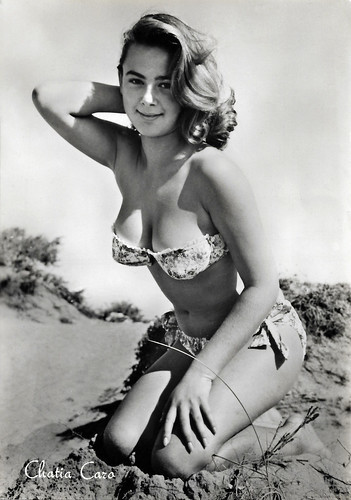
Italian postcard by Rotalfoto, Milano, no. 972.
Former French actress Cathia Caro (1943) was a young, delicate beauty. At the turn of the 1950s and 1960s, she starred in French and especially Italian films, opposite such stars as Totò , Peppino De Filippo and Aldo Fabrizi.
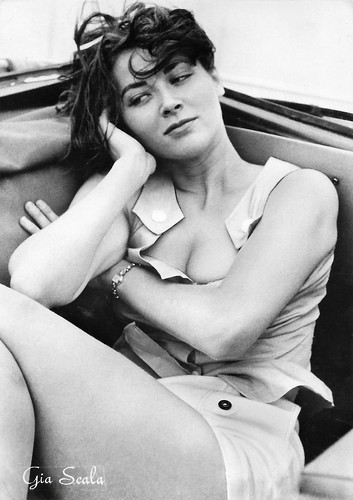
Italian postcard by Rotalfoto, Milano, no. 682.
Gia Scala (1934-1972) was a beautiful, sensitive English born Italian-American actress and model. Despite roles in such classics as The Guns of Navarone (1961), she never reached her full potential in Hollywood. The circumstances surrounding Scala's death at 36 by an overdose, have been questioned.
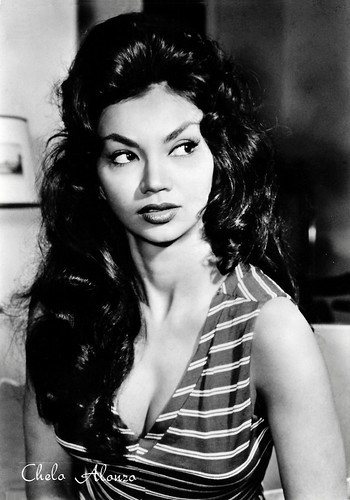
Italian postcard by Rotalfoto, no. 899.
Former Cuban actress, dancer and sex-symbol Chelo Alonso (1933-2019) was a star in the Italian cinema of the late 1950s and early 1960s. In several sword and sandal epics she played femme fatales with fiery tempers and she did sensual dance scenes, mixing Afro-Cuban rhythms with ‘bump and grind’. Ultimately in the DVD era, the ‘Cuban H-bomb’ became a cult heroine for many international B-film buffs.

Italian postcard, no. 607.
Swedish (but naturalised Italian) film actress Anita Ekberg had a Hollywood career in the 1950s, when she was contracted by studio mogul Howard Hughes. However, she got her real breakthrough in Italy. In Rome, she made film history as the sensual, curvaceous film goddess who dances in the Trevi Fountain in Fellini’s La Dolce Vita (1960).
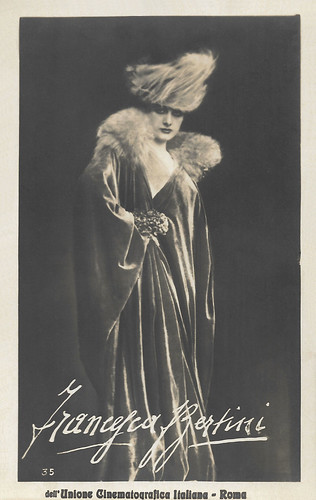
Italian postcard by Fotocelere, no. 35. Photo: Unione Cinematografia Italiana, Roma.
Majestic diva of the Italian silent cinema Francesca Bertini (1892-1985) was one of the first European film stars. During the first quarter of the twentieth century, she often played the 'femme fatale', with men devouring eyes, glamorous attire, clenched fists, and in opulent settings. She also starred in (and some say also directed) one of the first realist films in Italian cinema: Assunta Spina (1915).
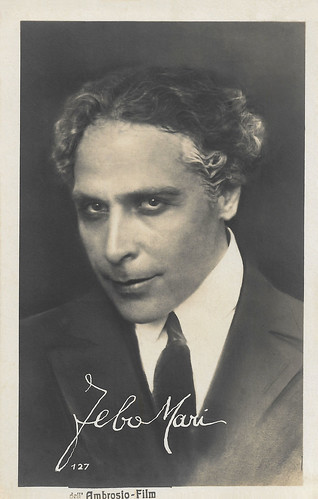
Italian postcard by Fotocelere, no. 127. Photo: Unione Cinematografia Italiana, Roma.
Febo Mari (1881-1939) was an Italian actor, director and writer of the stage, screen and radio, who peaked in the 1910s with films such as Il fuoco, Il fauno and Cenere.
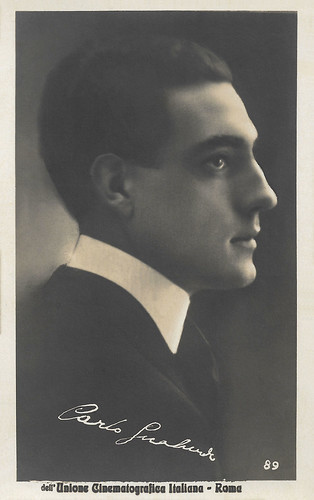
Italian postcard by Fotocelere, no. 89. Photo: Unione Cinematografia Italiana, Roma.
Carlo Gualandri (1895-1972) was an Italian film actor from the silent film era. His career set off from 1919, when he started to work in Rome for Cines and Celio, where he acted opposite such actors as Elena Lunda , Elena Sangro , Alberto Capozzi , etc.
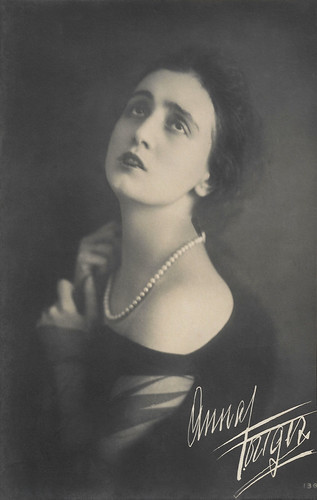
Italian postcard by Fotocelere, Torino, no. 136.
Anna Fougez (1894-1966) was a vaudeville star who shone on the Italian stage from the First World War to the mid-1920s. She also played in various Italian films.

German postcard by Ross Verlag, no. 33/2. Photo: Fritz Lang-Film / Ufa. Willy Fritsch in Spione/Spies (Fritz Lang, 1928).

French postcard in the Les Vedettes de Cinéma serie by A.N., Paris, no. 21. Photo: Paramount.
Theodore Roberts (1861-1928) was an American stage and screen actor, who is known for his many parts in films by Cecil B. DeMille and his brother William.

French postcard by A.N., Paris, no. 11.
Alice Nikitina (1904-1978) was a Russian dancer, teacher, and opera singer. She appeared in two films, The Blue Danube (1932) and Ma femme... homme d'affaires/My Wife as a Businessman (1932).

German postcard by Ross Verlag, no. 6676/2. Photo: Paramount. Marlene Dietrich as Shanghai Lily and Clive Brook as 'Doc' Harvey in Shanghai Express (Josef von Sternberg, 1932).

German postcard by Ross Verlag, no. 129/7. Photo: United Artists. Charlie Chaplin and Harry Myers in City Lights (Charles Chaplin, 1931).

French postcard by FA, no. 104. Photo: Talma.
French actress Andrée Spinelly (1887-1966) was commonly known as Spinelly. Her charm was celebrated by critics. During the 1930s, Spinelly starred in a few films.

German postcard by Ross Verlag, no. 5794/1, 1930-1931. Photo: Metro-Goldwyn-Mayer.
French actress Renée Adorée (1898-1933) appeared in Hollywood in several silent films during the 1920s. She is best known as Melisande in the successful war epic The Big Parade (King Vidor, 1925) opposite John Gilbert . She died a few days after her 35th birthday.

French postcard by Europe, no. 1121. Photo: MGM.
Marion Davies (1897-1961) was one of the great comedic actresses of the silent era. She starred in nearly four dozen films between 1917 and 1937.

German postcard by Ross Verlag, no. 119/1. Photo: Ufa. Willy Fritsch and Lilian Harvey in Liebeswalzer/Love Waltz (Wilhelm Thiele, 1930).

French postcard by Cinémagazine-Edition, Paris, no. 283. Photo: Paramount. Greta Nissen in The Wanderer (Raoul Walsh, 1925).

German postcard by Ross Verlag, no. 113/9. Photo: Ufa. Gerda Maurus and Gustav von Wangenheim in Frau im Mond/Woman in the Moon (Fritz Lang, 1929).

German postcard by Ross Verlag, no. 4329/1, 1929-1930. Photo: Paramount. Esther Ralston in The Case of Lena Smith (Josef von Sternberg, 1929).

German postcard by Ross Verlag, no. 5343/1, 1930-1931. Photo: MGM. Eleanor Boardman and Conrad Nagel in The Only Thing (1925).

German cigarette card by Monopol Film-Bilder, no. 90.
Stone-faced Buster Keaton (1895-1966) was one of the three greatest comedians of Silent Hollywood.

German cigarette card by Ross Verlag in the 'Künstler im Film' series for Zigarettenfabrik Monopol, Dresden, Serie 1, image 1. Photo: Ufa.
Beautiful Lída Baarová (1914-2000) was a glamorous Czech film star who worked in Prague, Berlin and Rome. A dangerous affair with Joseph Goebbels, the propaganda minister of the Third Reich, first enhanced and later seriously damaged her career.

German cigarette card by Ross Verlag in the Ramses Film-Fotos series for Jasmatzi Cigarettenfabrik, Dresden. Serie 1, Image no. 145. Photo: Vogel-Sandau.
Leni Riefenstahl (1902-2003) was the notorious director of Triumph des Willens (1935), a fascinating propaganda documentary about Adolf Hitler and the Third Reich, commissioned by the Nazi government. Before she started directing films, she worked as a dancer and on screen she became a star in the mountain films, directed by Arnold Fanck.

German cigarette card by Cigarettenfabrik Monopol, Dresden, no. 197. Photo: Lux Film Verl.
German film and screenwriter Maria Solveg or Maria Matray (1907–1993) was a star of the late Weimar cinema. When Hitler came to power, the Jewish actress went in exile and had a new career in the US as a choreographer and writer.

French postcard by Europe, no. 658. Photo: Warner Bros / Arta Film. Dolores Costello in Noah's Ark (Michael Curtiz, 1929).
American film actress Dolores Costello (1903-1979) was 'The Goddess of the Silent Screen'. She was Hollywood royalty: the daughter of popular matinee idol Maurice Costello, wife of John Barrymore and grandmother of Drew Barrymore.

French postcard by Europe, no. 1086. Photo: Studio Intran.
Lovely Dita Parlo (1906-1971) was a star of German and French films of the late 1920s and 1930s, who also worked in Hollywood. She inspired both Dita Von Teese and Madonna, the latter used her name and character from L'Atalante (1934) for her Sex book and Erotica album.

German postcard by Ross Verlag, no. 4014/1, 1929-1930. Photo: Atelier Sandau, Berlin.
Hungarian actress Käthe von Nagy (1904-1973) started as the ‘Backfish’ of German films of the late 1920s. In the early 1930s she became a fashionable and charming star of the German and French cinema.

Austrian postcard by Iris-Verlag, no. 5069. Photo: Manassé, Wien.
Polish born, German actress Dina Gralla (1905-1994) often appeared as a naive, sexy dancer in German revues, and in more than 35 silent and early sound films.

British postcard by Heroes Publishing Ltd., London, no. SPC 2894.
American actor and producer Tom Cruise (1962) became with his charismatic smile the most successful member of Hollywood's Brat Pack, the golden boys and girls of the 1980s. Top Gun (1985) made him an action star, but with his roles in The Color of Money (1986), Rain Man (1988) and Born on the Fourth of July (1989) he proved himself to be an all-round star and excellent actor. During the 1990s, he continued to combine action blockbusters like Mission Impossible (1996) with highly acclaimed dramas like A Few Good Men (1992), Eyes Wide Shut (1999) and Magnolia (1999). He received more praise for his roles in Minority Report (2000) and Collateral (2002) and was for years one of the highest paid actors in the world. Although he continued to score major box office hits with the Mission Impossible franchise, his later work was overshadowed by his outspoken attitude about Scientology which alienated him from many of his viewers.

Italian postcard by Rotalfoto, Milano, no. 972.
Former French actress Cathia Caro (1943) was a young, delicate beauty. At the turn of the 1950s and 1960s, she starred in French and especially Italian films, opposite such stars as Totò , Peppino De Filippo and Aldo Fabrizi.

Italian postcard by Rotalfoto, Milano, no. 682.
Gia Scala (1934-1972) was a beautiful, sensitive English born Italian-American actress and model. Despite roles in such classics as The Guns of Navarone (1961), she never reached her full potential in Hollywood. The circumstances surrounding Scala's death at 36 by an overdose, have been questioned.

Italian postcard by Rotalfoto, no. 899.
Former Cuban actress, dancer and sex-symbol Chelo Alonso (1933-2019) was a star in the Italian cinema of the late 1950s and early 1960s. In several sword and sandal epics she played femme fatales with fiery tempers and she did sensual dance scenes, mixing Afro-Cuban rhythms with ‘bump and grind’. Ultimately in the DVD era, the ‘Cuban H-bomb’ became a cult heroine for many international B-film buffs.

Italian postcard, no. 607.
Swedish (but naturalised Italian) film actress Anita Ekberg had a Hollywood career in the 1950s, when she was contracted by studio mogul Howard Hughes. However, she got her real breakthrough in Italy. In Rome, she made film history as the sensual, curvaceous film goddess who dances in the Trevi Fountain in Fellini’s La Dolce Vita (1960).

Italian postcard by Fotocelere, no. 35. Photo: Unione Cinematografia Italiana, Roma.
Majestic diva of the Italian silent cinema Francesca Bertini (1892-1985) was one of the first European film stars. During the first quarter of the twentieth century, she often played the 'femme fatale', with men devouring eyes, glamorous attire, clenched fists, and in opulent settings. She also starred in (and some say also directed) one of the first realist films in Italian cinema: Assunta Spina (1915).

Italian postcard by Fotocelere, no. 127. Photo: Unione Cinematografia Italiana, Roma.
Febo Mari (1881-1939) was an Italian actor, director and writer of the stage, screen and radio, who peaked in the 1910s with films such as Il fuoco, Il fauno and Cenere.

Italian postcard by Fotocelere, no. 89. Photo: Unione Cinematografia Italiana, Roma.
Carlo Gualandri (1895-1972) was an Italian film actor from the silent film era. His career set off from 1919, when he started to work in Rome for Cines and Celio, where he acted opposite such actors as Elena Lunda , Elena Sangro , Alberto Capozzi , etc.

Italian postcard by Fotocelere, Torino, no. 136.
Anna Fougez (1894-1966) was a vaudeville star who shone on the Italian stage from the First World War to the mid-1920s. She also played in various Italian films.
Published on April 03, 2020 22:00
April 2, 2020
Mara Corday
American actress Mara Corday (1930) was also a popular showgirl, model and Playboy Playmate of the 1950s. She starred in the cult classic Tarantula (1955) and many other B-pictures. Corday later appeared in several films of her friend Clint Eastwood.
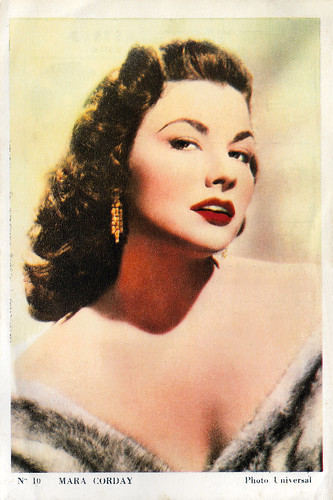
Belgian collectors card by Merbotex, Bruxelles (Brussels), no 10. Photo: Universal.
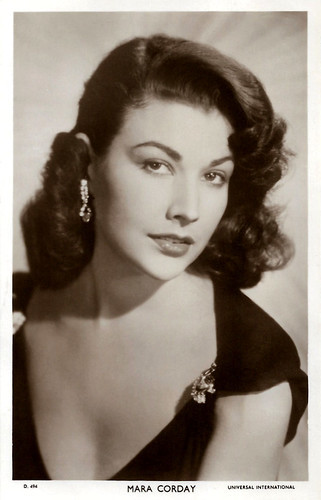
British postcard in the Picturegoer Series, no. D 494. Photo: Universal International.
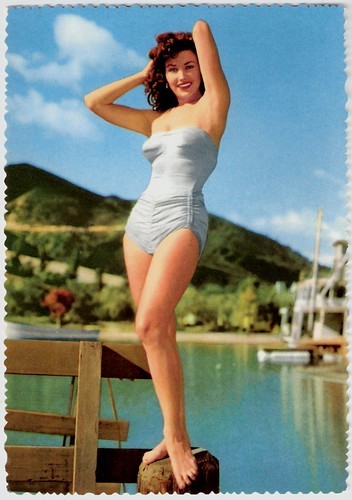
Italian postcard by Rotalcolor, no. 4.
Cult Success
Mara Corday was born Marilyn Joan Watts in Santa Monica, California, in 1930. Her parents were Emerson Watts and Shirley Wood, both hardworking middle-class but thrown into financial struggle during the Depression era. Her grandfather was David Watts, a Shakespearean actor. The family moved frequently until her father found steady work as a certified public accountant.
With her elder brother Richard, Marilyn often spent entire days at the local cinemas. By age 13, when her family moved to the greater Los Angeles area, she worked as an usherette in legitimate theatres. It provided her the opportunity to see first hand the behind the scenes inner workings of live stage productions and fed her developing aspirations to be an actress.
One day on the beach, at age 15, she was approached by a boy who needed a model for a photo contest in the local paper. Agreeing to pose, the picture was submitted and won the contest.
At 17, she 'advanced. her age to eighteen and found work dancing in the back row of the chorus at the Earl Carroll Theatre, the famous showman's theatre-restaurant on Sunset Boulevard. She fashioned herself the name Mara Corday - believing it to be more exotic or glamorous. Within the first year, Mara graduated from the ensemble line to principal showgirl. She went on to performing skits with the shows comic star, Pinky Lee.
When the theatre closed upon Earl Carroll's untimely death in a plane crash, Mara moved on to short stints dancing at Las Vegas' Last Frontier Hotel, George White Scandals of 1950 at the San Francisco's Geary Theatre, and briefly (as a blonde) in the Los Angeles Greek Theatre production of 'Gentlemen Prefer Blondes'.
Her physical beauty brought jobs as a photographer's model, and she became one of the most photographed models of her era. In 1951, Corday was lucky enough to appear in a small Los Angeles production of William Saroyan's 'The Time of Your Life', where she was seen by Paul Kohner, one of Hollywood's top agents. This led to a bit part as a showgirl in the film Two Tickets to Broadway (James V. Kern, 1951) starring Tony Martin.
Producer Hal Wallis saw Mara's photo in a magazine and screen-tested her and she joined his small stable of actors in 1953. She appeared as a waitress in the Wallis-produced Dean Martin/Jerry Lewis 3-D comedy Money From Home (George Marshall, 1953) at Paramount. Because Wallis' company was dissolved 6 months later, Mara's agent then took the screen test to Universal-International which had in place a 'talent program' offering a wide array of training in the dramatic arts.
With UIP, Corday was given small roles in various B-movies and television series. In 1954 on the set of Playgirl (Joseph Pevney, 1954), starring Shelley Winters, she met actor Richard Long. Following the death of Long's wife, the two began dating and they married in 1957.
Mara Corday appeared as a pin-up girl in numerous men's magazines during the 1950s. Having posed years earlier for an Esquire Magazine layout which was not used, the photographer sold the photos to Playboy Magazine and Mara thereby became the Playmate of the October 1958 issue of Playboy.
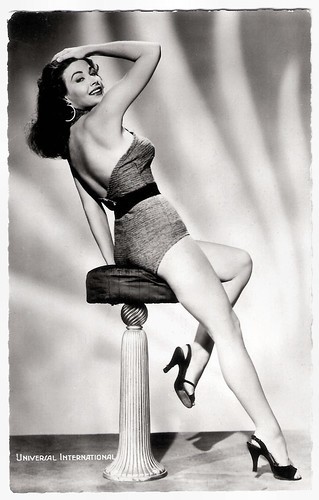
French postcard by Editions du Globe, no. 506. Photo: International Press.
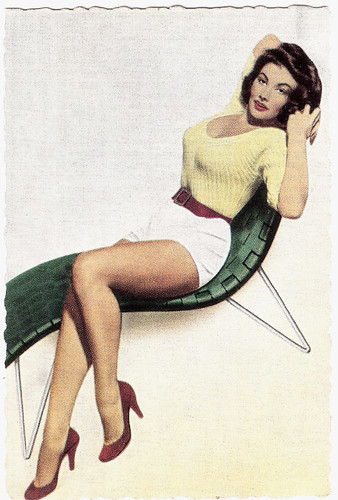
German collectors card by Druckerei Hanns Uhrig, Frankfurt a. M. Photo: Warner Bros. Pictures, Inc.
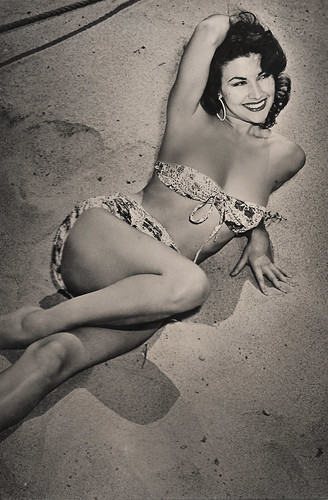
Spanish postcard, no. 39.
Iconic Sequence
Mara Corday's roles were small until 1955. Universal saw that Corday enjoyed a strong following and received a lot of fan mail, so the studio cast her in her first starring role with Lex Barker in the Western The Man from Bitter Ridge (Jack Arnold, 1955). The two co-stars had a romance, which lasted only until he married Lana Turner .
Then she was cast opposite John Agar in the Sci-Fi film Tarantula (Jack Arnold, 1955) as the demure, intelligent scientist's assistant. In Tarantula, a spider escapes from an isolated Arizona desert laboratory experimenting in giantism. In a brief period of time the spider grows to the size of a house, then an office building. Soon livestock and then people begin disappearing.
The B-film grossed more money for the studio than any other that year, and Mara was given the 'star' treatment and Radio and TV interviews, personal appearance tours and photo layouts all followed. In the long run, Tarantula (Jack Arnold, 1955) proved to be a cult success. At the set of the film, she met actor Clint Eastwood with whom she would remain lifelong friends.
She also appeared in the Kirk Douglas feature Man Without a Star (1955), directed by King Vidor. She was getting bigger and better roles in films aimed at mainstream audiences, including the Western A Day of Fury (Harmon Jones, 1956). In 1956, she had a recurring role in the ABC television series Combat Sergeant. From 1959 to early 1961, Corday worked exclusively doing guest spots on various television series.
When MCA took control of Universal-International, they completely phased-out the contract-player system. All but a few select male stars received termination notices. Mara went free-lancing.
Bruce Eder at AllMovie : " In The Giant Claw (Fred F. Sears, 1957), which suffered from ludicrous special effects, she was the best thing to look at in the movie, even for filmgoers under age 13; and in The Black Scorpion (Edward Ludwig, 1957), she even supplied her wardrobe, and looked nothing less than stunning in virtually all of her scenes, and got to act the role of a full-blooded heroine, complete with acts of bravery of her own."
Mara Corday then gave up her career to devote her time to raising a family. During her seventeen-year tumultuous marriage to Richard Long, she had three children, actress Valerie Long, Carey Long and Gregory Long. |uring the first year of the marriage, she had threatened to divorce her husband ten times , even going so far as hiring an attorney
A few years after her husband's death in 1974, Corday's friend Clint Eastwood offered her a chance to return to filmmaking with a supporting role in his film The Gauntlet (1977). She had a brief-but-significant role in Sudden Impact (Clint Eastwood, 1983), where she played the waitress dumping sugar into Harry Callahan's coffee in that film's iconic 'Go ahead, make my day' sequence.
And she acted with Eastwood again in Pink Cadillac (Buddy Van Horn, 1989) as well as in her last film, The Rookie (Clint Eastwood, 1990). Corday has been working on various film-related writing projects, and has also been delighted to discover that she has still many fans for her three cult films, Tarantula (1955), The Giant Claw (1957), and The Black Scorpion (1957).
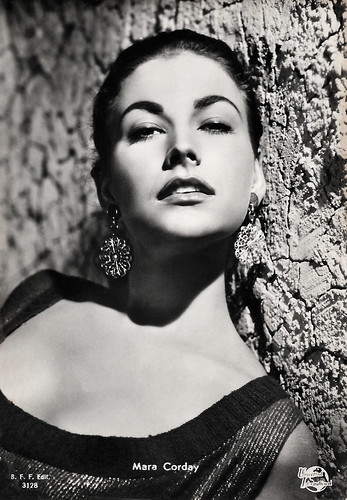
Italian postcard by B.F.F. Edit. (Casa Editr. Ballerini & Fratini, Firenze), no. 3128. Photo: Universal International.
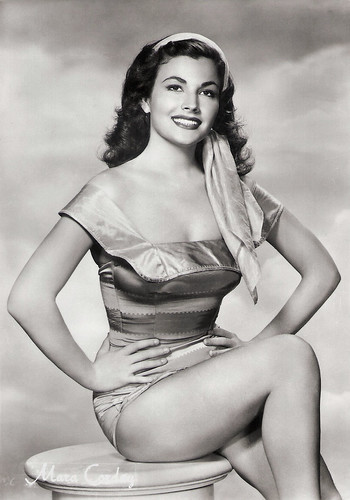
Italian postcard by Rotalfoto, no. 559. Photo: Universal International.
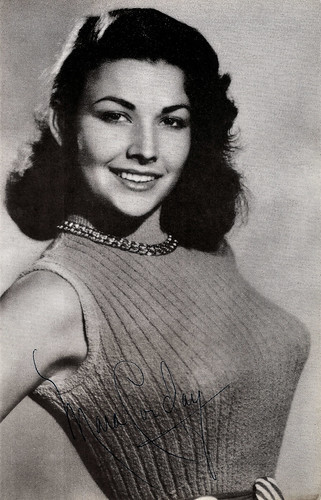
British postcard in the Celebrity Autograph Series by Celebrity Publishers, London, no. 220. Photo: Universal-International. Publicity still for Man Without a Star (King Vidor, 1955).
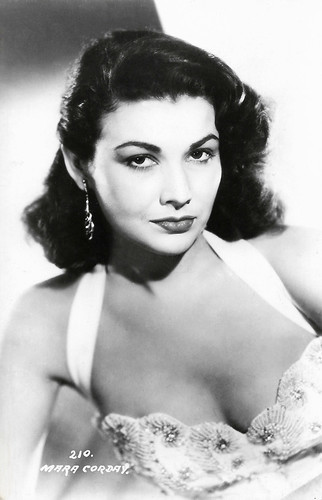
Spanish postcard, no. 210.
Sources: MaraCorday.com, Bruce Eder (AllMovie), (IMDb), Glamour Girls of the Silver Screen, Wikipedia and .

Belgian collectors card by Merbotex, Bruxelles (Brussels), no 10. Photo: Universal.

British postcard in the Picturegoer Series, no. D 494. Photo: Universal International.

Italian postcard by Rotalcolor, no. 4.
Cult Success
Mara Corday was born Marilyn Joan Watts in Santa Monica, California, in 1930. Her parents were Emerson Watts and Shirley Wood, both hardworking middle-class but thrown into financial struggle during the Depression era. Her grandfather was David Watts, a Shakespearean actor. The family moved frequently until her father found steady work as a certified public accountant.
With her elder brother Richard, Marilyn often spent entire days at the local cinemas. By age 13, when her family moved to the greater Los Angeles area, she worked as an usherette in legitimate theatres. It provided her the opportunity to see first hand the behind the scenes inner workings of live stage productions and fed her developing aspirations to be an actress.
One day on the beach, at age 15, she was approached by a boy who needed a model for a photo contest in the local paper. Agreeing to pose, the picture was submitted and won the contest.
At 17, she 'advanced. her age to eighteen and found work dancing in the back row of the chorus at the Earl Carroll Theatre, the famous showman's theatre-restaurant on Sunset Boulevard. She fashioned herself the name Mara Corday - believing it to be more exotic or glamorous. Within the first year, Mara graduated from the ensemble line to principal showgirl. She went on to performing skits with the shows comic star, Pinky Lee.
When the theatre closed upon Earl Carroll's untimely death in a plane crash, Mara moved on to short stints dancing at Las Vegas' Last Frontier Hotel, George White Scandals of 1950 at the San Francisco's Geary Theatre, and briefly (as a blonde) in the Los Angeles Greek Theatre production of 'Gentlemen Prefer Blondes'.
Her physical beauty brought jobs as a photographer's model, and she became one of the most photographed models of her era. In 1951, Corday was lucky enough to appear in a small Los Angeles production of William Saroyan's 'The Time of Your Life', where she was seen by Paul Kohner, one of Hollywood's top agents. This led to a bit part as a showgirl in the film Two Tickets to Broadway (James V. Kern, 1951) starring Tony Martin.
Producer Hal Wallis saw Mara's photo in a magazine and screen-tested her and she joined his small stable of actors in 1953. She appeared as a waitress in the Wallis-produced Dean Martin/Jerry Lewis 3-D comedy Money From Home (George Marshall, 1953) at Paramount. Because Wallis' company was dissolved 6 months later, Mara's agent then took the screen test to Universal-International which had in place a 'talent program' offering a wide array of training in the dramatic arts.
With UIP, Corday was given small roles in various B-movies and television series. In 1954 on the set of Playgirl (Joseph Pevney, 1954), starring Shelley Winters, she met actor Richard Long. Following the death of Long's wife, the two began dating and they married in 1957.
Mara Corday appeared as a pin-up girl in numerous men's magazines during the 1950s. Having posed years earlier for an Esquire Magazine layout which was not used, the photographer sold the photos to Playboy Magazine and Mara thereby became the Playmate of the October 1958 issue of Playboy.

French postcard by Editions du Globe, no. 506. Photo: International Press.

German collectors card by Druckerei Hanns Uhrig, Frankfurt a. M. Photo: Warner Bros. Pictures, Inc.

Spanish postcard, no. 39.
Iconic Sequence
Mara Corday's roles were small until 1955. Universal saw that Corday enjoyed a strong following and received a lot of fan mail, so the studio cast her in her first starring role with Lex Barker in the Western The Man from Bitter Ridge (Jack Arnold, 1955). The two co-stars had a romance, which lasted only until he married Lana Turner .
Then she was cast opposite John Agar in the Sci-Fi film Tarantula (Jack Arnold, 1955) as the demure, intelligent scientist's assistant. In Tarantula, a spider escapes from an isolated Arizona desert laboratory experimenting in giantism. In a brief period of time the spider grows to the size of a house, then an office building. Soon livestock and then people begin disappearing.
The B-film grossed more money for the studio than any other that year, and Mara was given the 'star' treatment and Radio and TV interviews, personal appearance tours and photo layouts all followed. In the long run, Tarantula (Jack Arnold, 1955) proved to be a cult success. At the set of the film, she met actor Clint Eastwood with whom she would remain lifelong friends.
She also appeared in the Kirk Douglas feature Man Without a Star (1955), directed by King Vidor. She was getting bigger and better roles in films aimed at mainstream audiences, including the Western A Day of Fury (Harmon Jones, 1956). In 1956, she had a recurring role in the ABC television series Combat Sergeant. From 1959 to early 1961, Corday worked exclusively doing guest spots on various television series.
When MCA took control of Universal-International, they completely phased-out the contract-player system. All but a few select male stars received termination notices. Mara went free-lancing.
Bruce Eder at AllMovie : " In The Giant Claw (Fred F. Sears, 1957), which suffered from ludicrous special effects, she was the best thing to look at in the movie, even for filmgoers under age 13; and in The Black Scorpion (Edward Ludwig, 1957), she even supplied her wardrobe, and looked nothing less than stunning in virtually all of her scenes, and got to act the role of a full-blooded heroine, complete with acts of bravery of her own."
Mara Corday then gave up her career to devote her time to raising a family. During her seventeen-year tumultuous marriage to Richard Long, she had three children, actress Valerie Long, Carey Long and Gregory Long. |uring the first year of the marriage, she had threatened to divorce her husband ten times , even going so far as hiring an attorney
A few years after her husband's death in 1974, Corday's friend Clint Eastwood offered her a chance to return to filmmaking with a supporting role in his film The Gauntlet (1977). She had a brief-but-significant role in Sudden Impact (Clint Eastwood, 1983), where she played the waitress dumping sugar into Harry Callahan's coffee in that film's iconic 'Go ahead, make my day' sequence.
And she acted with Eastwood again in Pink Cadillac (Buddy Van Horn, 1989) as well as in her last film, The Rookie (Clint Eastwood, 1990). Corday has been working on various film-related writing projects, and has also been delighted to discover that she has still many fans for her three cult films, Tarantula (1955), The Giant Claw (1957), and The Black Scorpion (1957).

Italian postcard by B.F.F. Edit. (Casa Editr. Ballerini & Fratini, Firenze), no. 3128. Photo: Universal International.

Italian postcard by Rotalfoto, no. 559. Photo: Universal International.

British postcard in the Celebrity Autograph Series by Celebrity Publishers, London, no. 220. Photo: Universal-International. Publicity still for Man Without a Star (King Vidor, 1955).

Spanish postcard, no. 210.
Sources: MaraCorday.com, Bruce Eder (AllMovie), (IMDb), Glamour Girls of the Silver Screen, Wikipedia and .
Published on April 02, 2020 22:00
April 1, 2020
Nicole Heesters
Austrian actress Nicole Heesters (1937) is the daughter of Dutch-born film star Johannes Heesters. With a rich film and stage career, she stepped out of the shadow of her famous father. As a film actress, she became known in the 1950s with such films as Dieses Lied bleibt bei Dir/Cabaret (Willi Forst, 1954). Later she played in dozens of TV films and series.
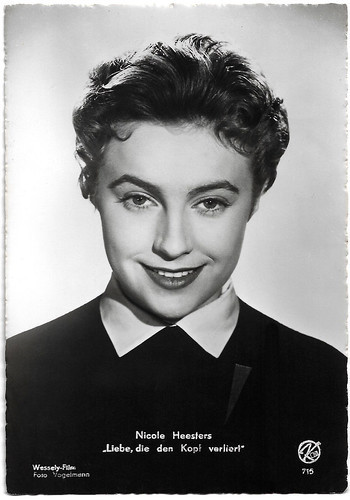
Austrian postcard by Kellner-Fotokarte, Wien, no. 715. Photo: Vogelmann / Wessely-Film. Nicole Heesters in Liebe, die den Kopf verliert/Love that loses its head (Thomas Engel, 1956).
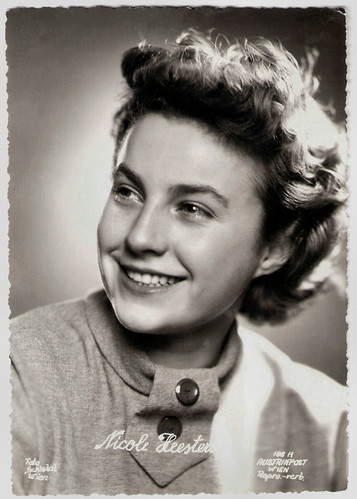
Austrian postcard by Austriapost, Wien, no. 108 A. Photo: Schistal, Wien.
Johannes's daughter
Nicole Heesters was born in 1937 in Potsdam, Germany. Her father was Dutch born actor and singer Johannes Heesters and her mother Belgian stage actress and operetta singer Louise Ghijs. Nicole's older sister Wiesje (1931) is a pianist in Vienna, Austria.
Nicole grew up in Austria and made her film debut as one of the daughters of Attila Hörbiger and Paula Wessely in the comedy Ich und meine Frau/I and My Wife (Eduard von Borsody, 1953).
During the 1950s, she also starred in such films as Dieses Lied bleibt bei Dir/Cabaret (Willi Forst, 1954) and the comedy Drei Männer im Schnee/Three Men in the Snow (Kurt Hoffmann, 1955), starring Paul Dahlke and based on the eponymous novel by Erich Kästner.
In 1954, she made her stage debut in the title role of Gigi at the Wiener Volkstheater. Next she was engaged by the Düsseldorfer Schauspielhaus.
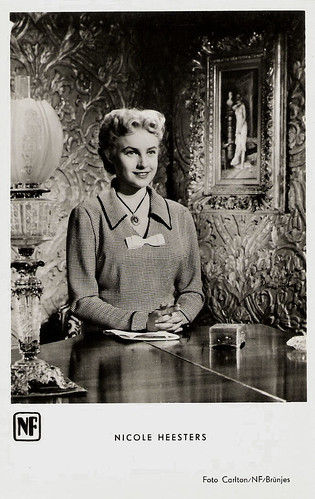
German postcard by Kunst und Bild, Berlin, no. A 1102. Photo: Carlton / NF / Brünjes. Nicole Heesters in Dieses Lied bleibt bei Dir/Cabaret (Willi Forst, 1954).
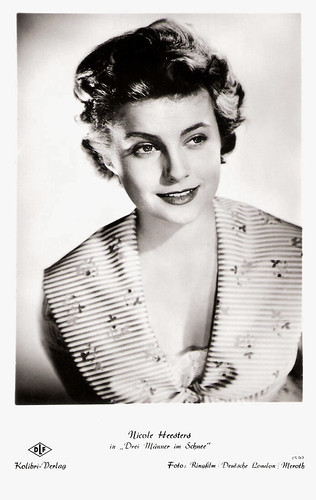
German postcard by Kolibri-Verlag no. 1530. Photo: Ringfilm / Deutsche London / Meroth. Nicole Heesters in Drei Männer im Schnee/Three Men in the Snow (Kurt Hoffmann, 1955).
The first female commissioner in Tatort
During the following decades, Nicole Heesters focused on stage and TV. In the theatre, she worked with such directors as Peter Stein, Boy Gobert and Andrea Breth.
Since 1973, she is a member of the Freien Akademie der Künste in Hamburg. On screen, she appeared in the TV film Geliebter Mörder/Beloved Murderer (Heinz Schirk, 1972).
She was Catherine II in the TV Mini-series Die unfreiwilligen Reisen des Moritz August Benjowski/Benjowski (Fritz Umgelter, 1975) with Christian Quadflieg, and she played opposite Rainer Werner Fassbinder in the Sci-Fi thriller Kamikaze 1989 (Wolf Gremm, 1982).
She was also the first female commissioner in the popular Krimi series Tatort/Crime Scene (1978-1980). More recently she played the title role of Lou Andreas-Salomé in The Audacity to be Free (Cordula Kablitz-Post, 2016).
In 1958, she married stage director Pit Fischer, and the couple remained together till his death in 2010. They had two children, including actress Saskia Fischer.
Nicole Heesters'newest film is the family film Die Wolf-Gäng/The Wolf Gang (Tim Trageser, 2020) with Christian Berkel.
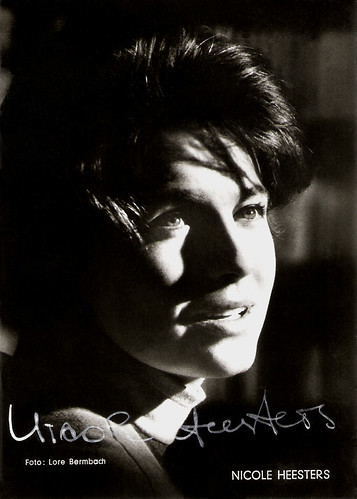
German autograph card. Photo: Lore Bermbach.
Sources: Wikipedia and .

Austrian postcard by Kellner-Fotokarte, Wien, no. 715. Photo: Vogelmann / Wessely-Film. Nicole Heesters in Liebe, die den Kopf verliert/Love that loses its head (Thomas Engel, 1956).

Austrian postcard by Austriapost, Wien, no. 108 A. Photo: Schistal, Wien.
Johannes's daughter
Nicole Heesters was born in 1937 in Potsdam, Germany. Her father was Dutch born actor and singer Johannes Heesters and her mother Belgian stage actress and operetta singer Louise Ghijs. Nicole's older sister Wiesje (1931) is a pianist in Vienna, Austria.
Nicole grew up in Austria and made her film debut as one of the daughters of Attila Hörbiger and Paula Wessely in the comedy Ich und meine Frau/I and My Wife (Eduard von Borsody, 1953).
During the 1950s, she also starred in such films as Dieses Lied bleibt bei Dir/Cabaret (Willi Forst, 1954) and the comedy Drei Männer im Schnee/Three Men in the Snow (Kurt Hoffmann, 1955), starring Paul Dahlke and based on the eponymous novel by Erich Kästner.
In 1954, she made her stage debut in the title role of Gigi at the Wiener Volkstheater. Next she was engaged by the Düsseldorfer Schauspielhaus.

German postcard by Kunst und Bild, Berlin, no. A 1102. Photo: Carlton / NF / Brünjes. Nicole Heesters in Dieses Lied bleibt bei Dir/Cabaret (Willi Forst, 1954).

German postcard by Kolibri-Verlag no. 1530. Photo: Ringfilm / Deutsche London / Meroth. Nicole Heesters in Drei Männer im Schnee/Three Men in the Snow (Kurt Hoffmann, 1955).
The first female commissioner in Tatort
During the following decades, Nicole Heesters focused on stage and TV. In the theatre, she worked with such directors as Peter Stein, Boy Gobert and Andrea Breth.
Since 1973, she is a member of the Freien Akademie der Künste in Hamburg. On screen, she appeared in the TV film Geliebter Mörder/Beloved Murderer (Heinz Schirk, 1972).
She was Catherine II in the TV Mini-series Die unfreiwilligen Reisen des Moritz August Benjowski/Benjowski (Fritz Umgelter, 1975) with Christian Quadflieg, and she played opposite Rainer Werner Fassbinder in the Sci-Fi thriller Kamikaze 1989 (Wolf Gremm, 1982).
She was also the first female commissioner in the popular Krimi series Tatort/Crime Scene (1978-1980). More recently she played the title role of Lou Andreas-Salomé in The Audacity to be Free (Cordula Kablitz-Post, 2016).
In 1958, she married stage director Pit Fischer, and the couple remained together till his death in 2010. They had two children, including actress Saskia Fischer.
Nicole Heesters'newest film is the family film Die Wolf-Gäng/The Wolf Gang (Tim Trageser, 2020) with Christian Berkel.

German autograph card. Photo: Lore Bermbach.
Sources: Wikipedia and .
Published on April 01, 2020 22:00
March 31, 2020
Françoise Brion
French film and stage actress Françoise Brion (1933) has appeared in 75 films since 1957. She worked with Nouvelle Vague directors like her husband Jacques Doniol-Valcroze, Pierre Kast and Alain Robbe-Grillet. She also was an attractive, blue-eyed, blonde eye-catcher in several crime films, in which she played the friend and lover of Eddie Constantine or Lino Ventura, or was a seductive and sometimes dangerous siren.
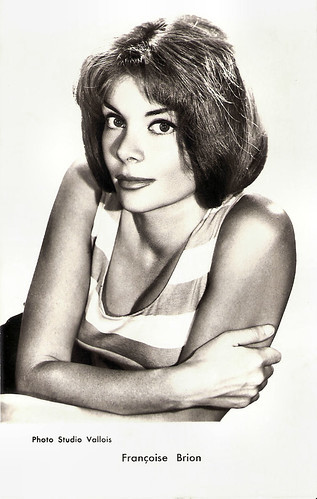
French postcard by Editions P.I., Paris, offered by Les Carbones Korès "Carboplane", no. 1089. Photo: Studio Vallois.
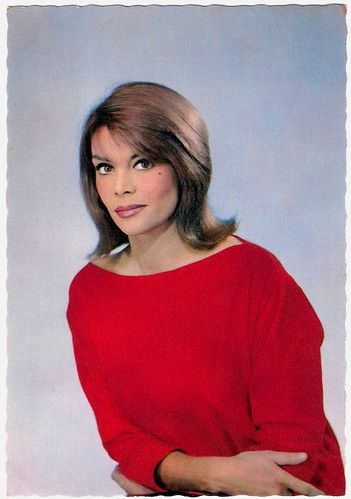
French postcard by E.D.U.G., no. 135. Photo: Sam Lévin.
Stage plays in metropolitan venues
Françoise Brion was born in 1933 in Paris, France as Françoise Alicia Rose German de Ribon.
She took acting lessons from Pierre Dux and Raymond Girard in the early 1950s and then continued to study at the Actors Studio in New York.
Back home in Paris, the pale blonde young artist mainly played theatre since 1955 and appeared in numerous stage plays in such metropolitan venues as the Théâtre de l'Œuvre, the Théâtre des Variétés, the Théâtre de Paris, the Théâtre de l'Atelier, de Théâtre national populaire and the Théâtre Sarah-Bernhardt.
She worked with the directors Robert Lamoureux , André Barsacq, Michael Cacoyannis and her teacher Pierre Dux. Brion received her most important early stage roles in Oscar Wilde's 'An Ideal Husband', in Françoise Sagan's 'A Castle in Sweden', in Peter Weiss’ 'Marat / Sade' as well as in Bertolt Brecht's ' Mutter Courage and her children'.
She has also been a guest at the Avignon Theatre Festival several times. Brion made her film debut with a minor role in Love in the Afternoon (Billy Wilder, 1957), starring Gary Cooper and Audrey Hepburn .
Her first bigger parts were in the crime film Un témoin dans la ville/Witness in the City (Édouard Molinaro, 1959) with Lino Ventura and the Romance Katia/Adorable Sinner (Robert Siodmak, 1959) with Romy Schneider .
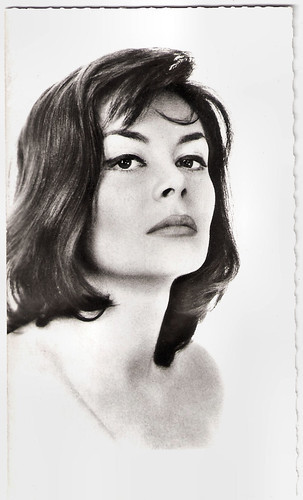
French postcard by Editions P.I., Paris, no. 1062. Photo: Sam Lévin.
A dreamlike, erotic fantasy
Françoise Brion had her first starring role in the Lemmy Caution crime film Comment qu'elle est?/Women Are Like That (Bernard Borderie, 1960) with Eddie Constantine .
That year, she also starred with Jean-Louis Trintignant in the film Le coeur battant/The French Game (1960) directed by Jacques Doniol-Valcroze, who later became her husband. She also starred in Doniol-Valcroze's La dénonciation/The Denunciation (Jacques Doniol-Valcroze, 1962), featuring Maurice Ronet as a traitor considered a hero after WW2.
Françoise Brion was, with Catherine Deneuve , Dany Saval and Françoise Arnoul , one of the title figures in the Anthology film Les Parisiennes/Tales of Paris (Marc Allégret, Claude Barma, Michel Boisrond, Jacques Poitrenaud, 1962). She also appeared in Et Satan conduit le bal/And Satan Calls the Turns (Grisha Dabat, 1962) starring Catherine Deneuve and Jacques Doniol-Valcroze.
The following year, she played the female lead in the French-Romanian crime film Codine (Henri Colpi, 1963), which was entered into the 1963 Cannes Film Festival where it won the award for Best Screenplay. She also played in the French-Italian comedy Dragées au poivre/Sweet and Sour (Jacques Baratier, 1963) starring Guy Bedos and Jean-Paul Belmondo .
Then followed the art film L'Immortelle (Alain Robbe-Grillet, 1963), which was entered into the 13th Berlin International Film Festival, and won the Prix Louis Delluc. Director Alain Robbe-Grillet, who was one of the most successful screenwriters of the French New Wave, had longed to direct a feature film, but for a long time no offers of backing were forthcoming.
At length, a Belgian producer agreed to let him direct a film from his own screenplay, on condition that the film be shot in Turkey, using 'blocked funds' (profits from an earlier film that could not be taken out of the country) owed to Cocinor, the French production company. Robbe-Grillet accepted this, and in his first feature film as a director, created a dreamlike, erotic fantasy. Robbe-Grillet wrote a very detailed plan for the shooting, and wanted it followed in every detail. Both Françoise Brion and co-star Jacques Doniol-Valcroze were friends of the director. Though he had written the scenario with other actors in mind, he decided on them instead.
Brion finished her very productive year with the French-Portuguese drama Vacances portugaises/Portuguese Vacation (Pierre Kast, 1963), with Michel Auclair and Jean-Pierre Aumont .
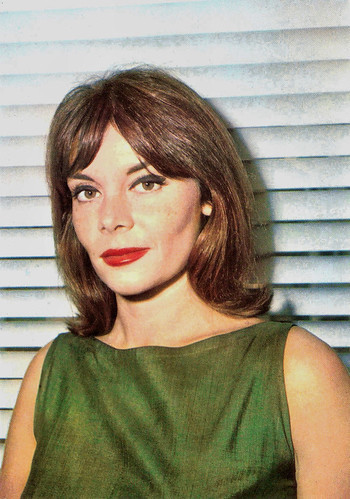
French postcard by Editions P.I., Paris, offered by Les Carbones Korès "Carboplane", no. 1074. Photo: Noa.
Interesting character roles
Françoise Brion played a supporting part in the French-Italian drama Un monde nouveau/A Young World (Vittorio De Sica, 1966) with Christine Delaroche and Nino Castelnuovo. Then she filmed in the Netherlands To Grab the Ring (Nikolai van der Heyde, 1968) with Ben Carruthers and Liesbeth List. It was entered into the 18th Berlin International Film Festival.
That year, she also appeared in the French comedy Alexandre le bienheureux/Very Happy Alexander (Yves Robert, 1968), also starring Philippe Noiret and Marlène Jobert . In the British-French action film Caravan to Vaccarès (Geoffrey Reeve, 1974) starring David Birney, Charlotte Rampling and Michael Lonsdale, she had a small part. It was loosely based on the novel 'Caravan to Vaccarès' by Alistair MacLean.
She also could be seen in Rosebud (Otto Preminger, 1975) with Peter O'Toole and Richard Attenborough , La traque/Gunman in the Streets (Serge Leroy, 1975), starring Mimsy Farmer and Jean-Luc Bideau, and the crime film Adieu poulet/The French Detective (Pierre Granier-Deferre, 1975) with Lino Ventura and Patrick Dewaere .
In 1978, she had a role in Attention, les enfants regardent/Careful, the Children Are Watching (Serge Leroy, 1978) with Alain Delon . With the gradual waning of her film career in the late 1970s, television gained importance in Brion's career, and she also intensified her work in the theatre again. In 1981-1982, she guest-starred in the French police television series Julien Fontanes, magistrat (1980-1989) with Jacques Morel. She also appeared in Jacques Doillon's film La tentation d'Isabelle/The Temptation of Isabelle (1985).
In her later years, around the mid-1990s, the artist was offered a number of interesting character roles in plays by authors as Thomas Bernhard, Edward Albee, Ingmar Bergman and Harold Pinter. Her later films include the French-Italian comedy Il conte Max/Count Max (Christian De Sica, 1991) and starring De Sica and Ornella Muti, Nelly et Monsieur Arnaud/Nelly and Mr. Arnaud (Claude Sautet, 1995) starring Michel Serrault and Emmanuelle Béart , and the French-American romantic comedy-drama Le Divorce (James Ivory, 2003) with Kate Hudson and Naomi Watts.
On TV, she could be seen in the French Mini-series Les Liaisons dangereuses/Dangerous Liaisons (Josée Dayan, 2003) starring Catherine Deneuve , Rupert Everett , Nastassja Kinski and Leelee Sobieski. It was an updated adaptation of the classic eighteenth-century novel 'Les Liaisons dangereuses' by Pierre Choderlos de Laclos. Her most recent film is Le premier jour du reste de ta vie/The First Day of the Rest of Your Life (Rémi Bezançon, 2008), the tale of a close knit family over a period of twelve years.
Françoise Brion was married to actor Paul Guers (1958-1963). After their divorce, she married actor-director Jacques Doniol-Valcroze, with whom she had two children, actress Diane Doniol-Valcroze and director-writer Simon Doniol-Valcroze.
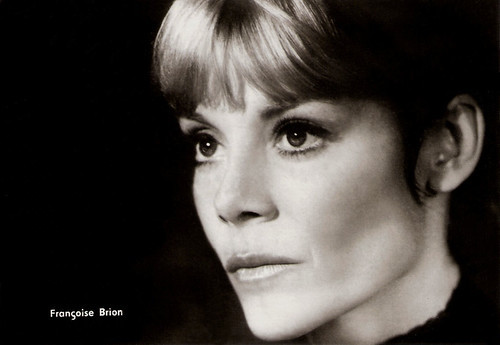
East-German postcard by VEB Progress Film-Vertrieb, Berlin, no. 117/69. Francoise Brion in Alexandre le bienheureux/Very Happy Alexander (Yves Robert, 1968).
Scene from L'Immortelle (Alain Robbe-Grillet, 1963). Source: Pierre Marascia (YouTube).
Sources: Wikipedia (English and German) and .

French postcard by Editions P.I., Paris, offered by Les Carbones Korès "Carboplane", no. 1089. Photo: Studio Vallois.

French postcard by E.D.U.G., no. 135. Photo: Sam Lévin.
Stage plays in metropolitan venues
Françoise Brion was born in 1933 in Paris, France as Françoise Alicia Rose German de Ribon.
She took acting lessons from Pierre Dux and Raymond Girard in the early 1950s and then continued to study at the Actors Studio in New York.
Back home in Paris, the pale blonde young artist mainly played theatre since 1955 and appeared in numerous stage plays in such metropolitan venues as the Théâtre de l'Œuvre, the Théâtre des Variétés, the Théâtre de Paris, the Théâtre de l'Atelier, de Théâtre national populaire and the Théâtre Sarah-Bernhardt.
She worked with the directors Robert Lamoureux , André Barsacq, Michael Cacoyannis and her teacher Pierre Dux. Brion received her most important early stage roles in Oscar Wilde's 'An Ideal Husband', in Françoise Sagan's 'A Castle in Sweden', in Peter Weiss’ 'Marat / Sade' as well as in Bertolt Brecht's ' Mutter Courage and her children'.
She has also been a guest at the Avignon Theatre Festival several times. Brion made her film debut with a minor role in Love in the Afternoon (Billy Wilder, 1957), starring Gary Cooper and Audrey Hepburn .
Her first bigger parts were in the crime film Un témoin dans la ville/Witness in the City (Édouard Molinaro, 1959) with Lino Ventura and the Romance Katia/Adorable Sinner (Robert Siodmak, 1959) with Romy Schneider .

French postcard by Editions P.I., Paris, no. 1062. Photo: Sam Lévin.
A dreamlike, erotic fantasy
Françoise Brion had her first starring role in the Lemmy Caution crime film Comment qu'elle est?/Women Are Like That (Bernard Borderie, 1960) with Eddie Constantine .
That year, she also starred with Jean-Louis Trintignant in the film Le coeur battant/The French Game (1960) directed by Jacques Doniol-Valcroze, who later became her husband. She also starred in Doniol-Valcroze's La dénonciation/The Denunciation (Jacques Doniol-Valcroze, 1962), featuring Maurice Ronet as a traitor considered a hero after WW2.
Françoise Brion was, with Catherine Deneuve , Dany Saval and Françoise Arnoul , one of the title figures in the Anthology film Les Parisiennes/Tales of Paris (Marc Allégret, Claude Barma, Michel Boisrond, Jacques Poitrenaud, 1962). She also appeared in Et Satan conduit le bal/And Satan Calls the Turns (Grisha Dabat, 1962) starring Catherine Deneuve and Jacques Doniol-Valcroze.
The following year, she played the female lead in the French-Romanian crime film Codine (Henri Colpi, 1963), which was entered into the 1963 Cannes Film Festival where it won the award for Best Screenplay. She also played in the French-Italian comedy Dragées au poivre/Sweet and Sour (Jacques Baratier, 1963) starring Guy Bedos and Jean-Paul Belmondo .
Then followed the art film L'Immortelle (Alain Robbe-Grillet, 1963), which was entered into the 13th Berlin International Film Festival, and won the Prix Louis Delluc. Director Alain Robbe-Grillet, who was one of the most successful screenwriters of the French New Wave, had longed to direct a feature film, but for a long time no offers of backing were forthcoming.
At length, a Belgian producer agreed to let him direct a film from his own screenplay, on condition that the film be shot in Turkey, using 'blocked funds' (profits from an earlier film that could not be taken out of the country) owed to Cocinor, the French production company. Robbe-Grillet accepted this, and in his first feature film as a director, created a dreamlike, erotic fantasy. Robbe-Grillet wrote a very detailed plan for the shooting, and wanted it followed in every detail. Both Françoise Brion and co-star Jacques Doniol-Valcroze were friends of the director. Though he had written the scenario with other actors in mind, he decided on them instead.
Brion finished her very productive year with the French-Portuguese drama Vacances portugaises/Portuguese Vacation (Pierre Kast, 1963), with Michel Auclair and Jean-Pierre Aumont .

French postcard by Editions P.I., Paris, offered by Les Carbones Korès "Carboplane", no. 1074. Photo: Noa.
Interesting character roles
Françoise Brion played a supporting part in the French-Italian drama Un monde nouveau/A Young World (Vittorio De Sica, 1966) with Christine Delaroche and Nino Castelnuovo. Then she filmed in the Netherlands To Grab the Ring (Nikolai van der Heyde, 1968) with Ben Carruthers and Liesbeth List. It was entered into the 18th Berlin International Film Festival.
That year, she also appeared in the French comedy Alexandre le bienheureux/Very Happy Alexander (Yves Robert, 1968), also starring Philippe Noiret and Marlène Jobert . In the British-French action film Caravan to Vaccarès (Geoffrey Reeve, 1974) starring David Birney, Charlotte Rampling and Michael Lonsdale, she had a small part. It was loosely based on the novel 'Caravan to Vaccarès' by Alistair MacLean.
She also could be seen in Rosebud (Otto Preminger, 1975) with Peter O'Toole and Richard Attenborough , La traque/Gunman in the Streets (Serge Leroy, 1975), starring Mimsy Farmer and Jean-Luc Bideau, and the crime film Adieu poulet/The French Detective (Pierre Granier-Deferre, 1975) with Lino Ventura and Patrick Dewaere .
In 1978, she had a role in Attention, les enfants regardent/Careful, the Children Are Watching (Serge Leroy, 1978) with Alain Delon . With the gradual waning of her film career in the late 1970s, television gained importance in Brion's career, and she also intensified her work in the theatre again. In 1981-1982, she guest-starred in the French police television series Julien Fontanes, magistrat (1980-1989) with Jacques Morel. She also appeared in Jacques Doillon's film La tentation d'Isabelle/The Temptation of Isabelle (1985).
In her later years, around the mid-1990s, the artist was offered a number of interesting character roles in plays by authors as Thomas Bernhard, Edward Albee, Ingmar Bergman and Harold Pinter. Her later films include the French-Italian comedy Il conte Max/Count Max (Christian De Sica, 1991) and starring De Sica and Ornella Muti, Nelly et Monsieur Arnaud/Nelly and Mr. Arnaud (Claude Sautet, 1995) starring Michel Serrault and Emmanuelle Béart , and the French-American romantic comedy-drama Le Divorce (James Ivory, 2003) with Kate Hudson and Naomi Watts.
On TV, she could be seen in the French Mini-series Les Liaisons dangereuses/Dangerous Liaisons (Josée Dayan, 2003) starring Catherine Deneuve , Rupert Everett , Nastassja Kinski and Leelee Sobieski. It was an updated adaptation of the classic eighteenth-century novel 'Les Liaisons dangereuses' by Pierre Choderlos de Laclos. Her most recent film is Le premier jour du reste de ta vie/The First Day of the Rest of Your Life (Rémi Bezançon, 2008), the tale of a close knit family over a period of twelve years.
Françoise Brion was married to actor Paul Guers (1958-1963). After their divorce, she married actor-director Jacques Doniol-Valcroze, with whom she had two children, actress Diane Doniol-Valcroze and director-writer Simon Doniol-Valcroze.

East-German postcard by VEB Progress Film-Vertrieb, Berlin, no. 117/69. Francoise Brion in Alexandre le bienheureux/Very Happy Alexander (Yves Robert, 1968).
Scene from L'Immortelle (Alain Robbe-Grillet, 1963). Source: Pierre Marascia (YouTube).
Sources: Wikipedia (English and German) and .
Published on March 31, 2020 22:00
March 30, 2020
Gli ultimi zar (1928)
Bartolomeo Pagano aka Maciste starred in the late Italian silent film Gli ultimi zar/The Last Tsars (Baldassarre Negroni, 1928). It was the penultimate film of the legendary strongman and also of his co-star Elena Lunda.
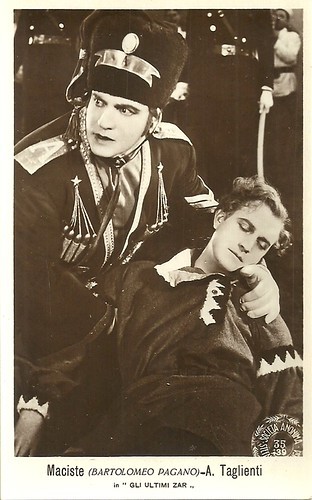
Italian postcard by S.A. Stefano Pittaluga, no. 439. Photo: Pittaluga. Bartolomeo Pagano and Amilcare Taglienti in Gli ultimi zar (Baldassarre Negroni, Pittaluga 1928).
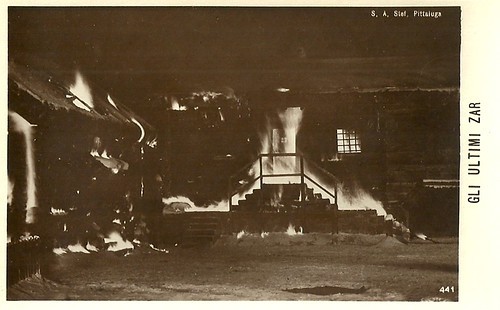
Italian postcard by S.A. Stefano Pittaluga, no. 441. Photo: Pittaluga. Publicity still for Gli ultimi zar (Baldassarre Negroni, 1928).
A generous and giant philosopher
In Gli ultimi zar/The Last Tsars (Baldassarre Negroni, 1928), the reign of Tsar Alexander III (Sandro Ruffini) starts to waver. He doesn't seem to have the character of a dictator, as he trembles each time his Minister of Police ( Alberto Pasquali ) pushes him to sign a new list of condemned people.
One day, Sergio Pawlow (Amilcare Taglienti) meets a group of deported people. An evil guard, Lt. Ermolow (Franz Sala), is martyring an old man who dies of fatigue. Sergio is furious, grabs the guard's whip and strikes him in the face.
He is arrested and added to the group of deported, while his grieving mother ( Elena Lunda ) follows him, her only son. Among the group is a peculiar philosopher, a generous and giant kind of man, called Lobov ( Bartolomeo Pagano ), who promises the other they will soon be free.
Indeed, one night he breaks the chains, but a giant fire breaks out in which the deported and the guards perish, apart from Lobov, Sergio and his mother, and the lieutenant's yeoman (Augusto Bandini).
The three man, wearing the uniforms of the officers, return to their homeland, where the Tsar, impressed by his physique, names him his aid. Sergio, though is imprisoned, so his mother goes to the Tsar to beg for mercy. It is only then that she recognises the Tsar as the father of Sergio. Sergio is graced and can henceforth lead a quiet life with his mother in a countryside house.
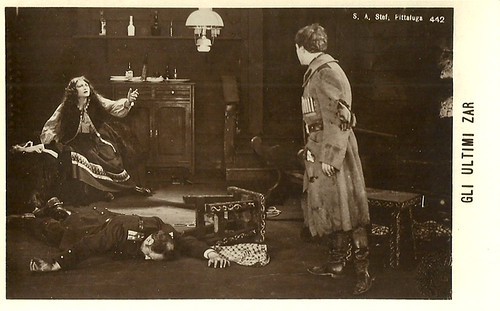
Italian postcard by S.A. Stefano Pittaluga, no. 442. Photo: Pittaluga. Elena Lunda , Franz Sala (the corpse on the ground), and Amilcare Taglienti in Gli ultimi zar (Baldassarre Negroni, 1928).
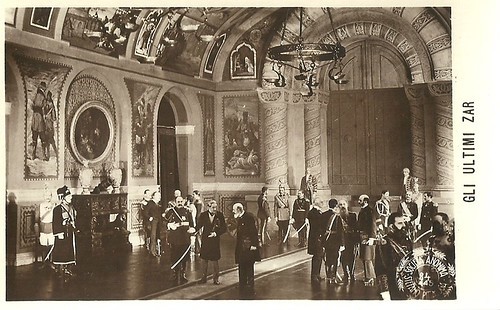
Italian postcard by S.A. Stefano Pittaluga, no. 445. Photo: Pittaluga. Publicity still for Gli ultimi zar (Baldassarre Negroni, 1928).
The penultimate film of strongman Pagano
The Italian press was split up in its judgements about Gli ultimi zar/The Last Tsars (Baldassarre Negroni, 1928).
Mario Serandrei, future editor of e.g. Luchino Visconti's Ossessione (1943), wrote for the Roman journal Cinematografo, that story, sets and acting were rather mediocre, old-hat and lacking a relationship with Italy.
Instead, A. Ghidoni, in another Roman journal, Kinès, remarked that the film was based on a highly popular Italian dime novel by Emilio Valabrega and he praised the atmosphere, the acting and the musical accompaniment.
Gli ultimi zar was the penultimate film of Bartolomeo Pagano , who was constantly indicated in the press as 'Maciste', even if his character in the film is named otherwise. He was too famous as the strongman.
The film was also the penultimate film for Elena Lunda , who had already acted opposite Pagano in Il gigante delle Dolomiti (1927). Gli ultimi zar had sets by Giulio Lombardozzi and cinematography by Ubaldo Arata.
Gli ultimi zar/The Last Tsars, which already had been censored in July 1928, had its Roman premiere on 28 December 1928.
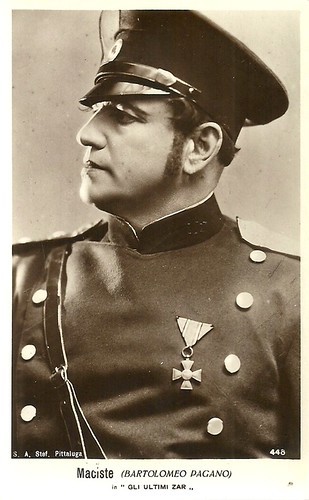
Italian postcard by S.A. Stefano Pittaluga, no. 448. Photo: Pittaluga. Bartolomeo Pagano aka Maciste in Gli ultimi zar (Baldassarre Negroni, 1928).
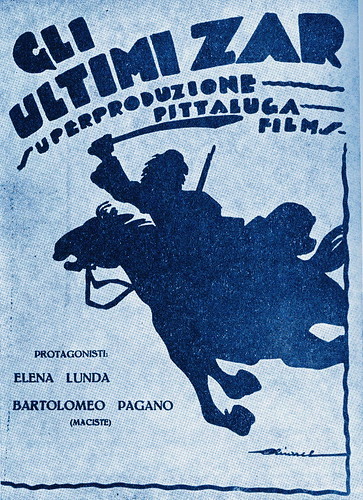
Italian silent film publicity for Gli ultimi zar (Baldassarre Negroni, 1928). Collection: Gerry D. (Flickr).
Sources: Vittorio Martinelli (Il cinema muto italiano, Vol. 1923-31), Wikipedia (English and Italian) and IMDb.

Italian postcard by S.A. Stefano Pittaluga, no. 439. Photo: Pittaluga. Bartolomeo Pagano and Amilcare Taglienti in Gli ultimi zar (Baldassarre Negroni, Pittaluga 1928).

Italian postcard by S.A. Stefano Pittaluga, no. 441. Photo: Pittaluga. Publicity still for Gli ultimi zar (Baldassarre Negroni, 1928).
A generous and giant philosopher
In Gli ultimi zar/The Last Tsars (Baldassarre Negroni, 1928), the reign of Tsar Alexander III (Sandro Ruffini) starts to waver. He doesn't seem to have the character of a dictator, as he trembles each time his Minister of Police ( Alberto Pasquali ) pushes him to sign a new list of condemned people.
One day, Sergio Pawlow (Amilcare Taglienti) meets a group of deported people. An evil guard, Lt. Ermolow (Franz Sala), is martyring an old man who dies of fatigue. Sergio is furious, grabs the guard's whip and strikes him in the face.
He is arrested and added to the group of deported, while his grieving mother ( Elena Lunda ) follows him, her only son. Among the group is a peculiar philosopher, a generous and giant kind of man, called Lobov ( Bartolomeo Pagano ), who promises the other they will soon be free.
Indeed, one night he breaks the chains, but a giant fire breaks out in which the deported and the guards perish, apart from Lobov, Sergio and his mother, and the lieutenant's yeoman (Augusto Bandini).
The three man, wearing the uniforms of the officers, return to their homeland, where the Tsar, impressed by his physique, names him his aid. Sergio, though is imprisoned, so his mother goes to the Tsar to beg for mercy. It is only then that she recognises the Tsar as the father of Sergio. Sergio is graced and can henceforth lead a quiet life with his mother in a countryside house.

Italian postcard by S.A. Stefano Pittaluga, no. 442. Photo: Pittaluga. Elena Lunda , Franz Sala (the corpse on the ground), and Amilcare Taglienti in Gli ultimi zar (Baldassarre Negroni, 1928).

Italian postcard by S.A. Stefano Pittaluga, no. 445. Photo: Pittaluga. Publicity still for Gli ultimi zar (Baldassarre Negroni, 1928).
The penultimate film of strongman Pagano
The Italian press was split up in its judgements about Gli ultimi zar/The Last Tsars (Baldassarre Negroni, 1928).
Mario Serandrei, future editor of e.g. Luchino Visconti's Ossessione (1943), wrote for the Roman journal Cinematografo, that story, sets and acting were rather mediocre, old-hat and lacking a relationship with Italy.
Instead, A. Ghidoni, in another Roman journal, Kinès, remarked that the film was based on a highly popular Italian dime novel by Emilio Valabrega and he praised the atmosphere, the acting and the musical accompaniment.
Gli ultimi zar was the penultimate film of Bartolomeo Pagano , who was constantly indicated in the press as 'Maciste', even if his character in the film is named otherwise. He was too famous as the strongman.
The film was also the penultimate film for Elena Lunda , who had already acted opposite Pagano in Il gigante delle Dolomiti (1927). Gli ultimi zar had sets by Giulio Lombardozzi and cinematography by Ubaldo Arata.
Gli ultimi zar/The Last Tsars, which already had been censored in July 1928, had its Roman premiere on 28 December 1928.

Italian postcard by S.A. Stefano Pittaluga, no. 448. Photo: Pittaluga. Bartolomeo Pagano aka Maciste in Gli ultimi zar (Baldassarre Negroni, 1928).

Italian silent film publicity for Gli ultimi zar (Baldassarre Negroni, 1928). Collection: Gerry D. (Flickr).
Sources: Vittorio Martinelli (Il cinema muto italiano, Vol. 1923-31), Wikipedia (English and Italian) and IMDb.
Published on March 30, 2020 22:00
March 29, 2020
Jerry Lewis
Legendary American comedian, actor and director Jerry Lewis (1926-2017) scored in just about every branch of show business: nightclubs, radio, television, concerts, films and records. Lewis rose to fame in a comedy duo with Dean Martin, and his slapstick humour carried him through decades of film, television, stage and radio shows. Jerry was most popular in Europe, especially in France.
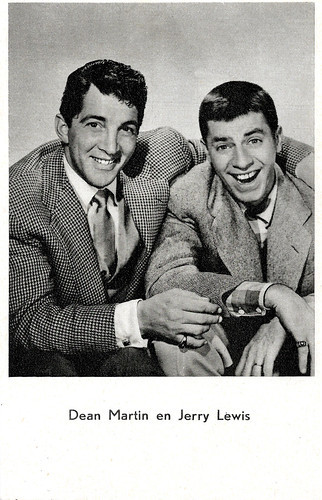
Dutch card. Dean Martin and Jerry Lewis.
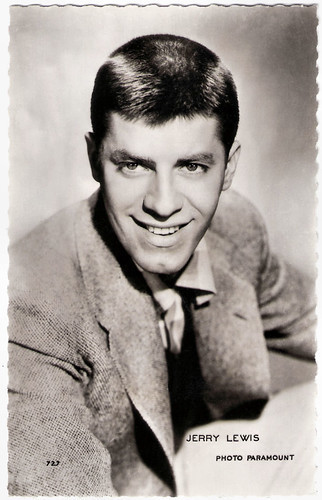
French postcard by Editions P.I., Paris, offered by Les Carbones Korès Carboplane, no. 2 12 G. Photo: Paramount Pictures, 1958.

Spanish postcard by Archivo Bermejo, no. C. 238, 1964. Photo; Paramount Films. Publicity still for Who's Minding the Store? (Frank Tashlin, 1963).
One of the greatest partnerships in the history of American show business
Jerry Lewis was born Joseph Levitch in 1926, in Newark, New Jersey. He grew up performing in a vaudeville family. His father, Daniel Levitch, who went by the stage name Danny Lewis, was a master of ceremonies and vaudeville entertainer. His mother, Rae Lewis, played piano for the New York City radio station WOR and was her husband's musical director.
Lewis began following in his parents' footsteps, making his debut at the age of 5, singing Brother, Can You Spare a Dime? at 'Borscht Belt' nightclubs in the Catskill Mountains in New York. At the age of 15, Jerry Lewis dropped out of school to pursue a full-time career as a performer. He devised a comedy routine known as the Record Act in which he mimed and mouthed the lyrics to operatic and popular songs while a phonograph played the songs offstage.
Lewis worked as a theatre usher and soda jerk to make ends meet. He grew depressed and was on the verge of giving up on his show-business dreams when a friend of his father's, the comedian Max Coleman, convinced him to give comedy another shot. Lewis soon caught the attention of another comedian, Irving Kaye, who became the young comic's manager and helped his career along through more Borscht Belt appearances.
In 1946, singer Dean Martin joined Lewis as a performer at the 500 Club, and one of the greatest partnerships in the history of American show business was born. Their zany act began with Martin singing a song only to be interrupted by Lewis, with the routine soon devolving into a hilarious improvised sequence that included ad-libbed insults, food fights and frequent banter with the audience.
Billed as Martin and Lewis, the duo became such an instantaneous success that in a matter of months they went from earning $250 a week to a whopping $5,000. They made a successful transition to the big screen with My Friend Irma (George Marshall, 1949), based on the popular radio series of the same name. This was followed by the sequel My Friend Irma Goes West (Hal Walker, 1950).
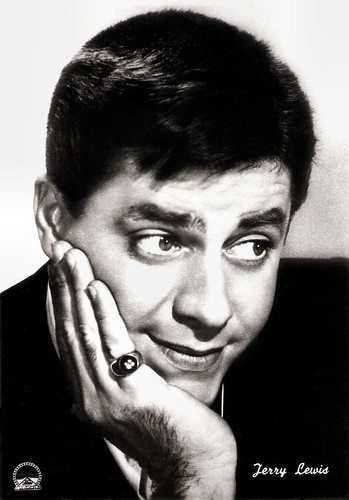
Italian postcard by Bromophoto, Milano, no. 1501. Photo: Paramount Films.
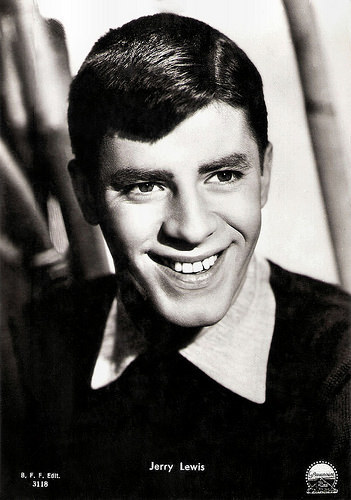
Italian postcard by Casa Editr. Balerini & Fratini, Firenze (Florence), no. 3119. Photo: Paramount Films.
Egotism and insensitivity
Over the next decade, Dean Martin and Jerry Lewis made 16 films together, including The Stooge (Norman Taurog, 1952), The Caddy (Norman Taurog, 1952), Artists and Models (Frank Tashlin, 1955), co-starring Shirley MacLaine and Dorothy Malone, and finally Hollywood or Bust (Frank Tashlin, 1956) with Anita Ekberg .
The pair also made frequent television appearances on The Ed Sullivan Show and The Colgate Comedy Hour. However, by the mid-1950s their partnership and friendship began to fray as Lewis received greater national attention and, as he admitted later, drove Martin away with his egotism and insensitivity. The two split ways, both professionally and personally, in 1956.
Teaming with director Frank Tashlin, whose background as a Warner Bros. Looney Tunes cartoon director suited Lewis's brand of humor, he starred in five more films, The Sad Sack (George Marshall, 1957), Rock-A-Bye Baby (Frank Tashlin, 1958), The Geisha Boy (Frank Tashlin, 1958), Don't Give Up The Ship (Norman Taurog, 1959) and even appeared uncredited as Itchy McRabbitt in Li'l Abner (Melvin Frank, 1959).
Lewis also enjoyed solo success with films like The Delicate Delinquent (Don McGuire, 1957) with Martha Hyer , The Ladies Man (Jerry Lewis, 1961) and The Nutty Professor (Jerry Lewis, 1963) with Stella Stevens. He made his directorial debut with the comedy The Bellboy (Jerry Lewis, 1960). The film marked the pioneering use of a video assist system, providing Lewis a way to see the action even though he was in the scene.
Later Lewis films were Who's Minding the Store? (Frank Tashlin, 1963), The Patsy (Jerry Lewis, 1964) and The Disorderly Orderly (Frank Tashlin, 1964). Lewis directed and co-wrote The Family Jewels (1965) about a young heiress who must choose among six uncles, one of whom is up to no good and out to harm the girl's beloved bodyguard who practically raised her. Lewis played all six uncles and the bodyguard.
Lewis would also appear opposite Tony Curtis and Dany Saval in Boeing Boeing (John Rich, 1965).
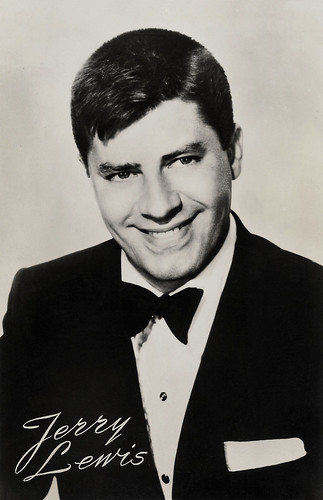
Dutch postcard by Uitg. Takken, Utrecht, no. AX 3710. Sent by mail in 1960.
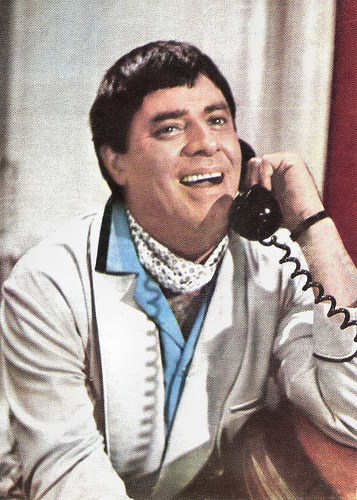
Romanian postcard by Casa Filmului Acin.
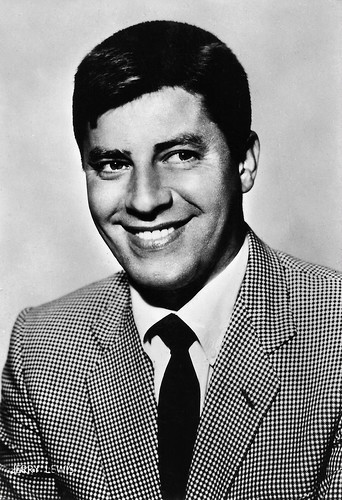
Italian postcard, no. 579.
The King of Comedy
In 1967 Jerry Lewis began teaching graduate film courses at the University of Southern California. His lectures were collected into a book, The Total Film-Maker (1971), which is considered a seminal text in the industry. In England he made Don't Raise the Bridge, Lower the River (Jerry Paris, 1968) with Terry-Thomas.
His career hit a rough patch in the 1970s, though he remained highly popular in Europe, especially in France. in Sweden he filmed the drama The Day the Clown Cried (Jerry Lewis, 1972), about a German clown who was arrested by the Gestapo, interred in a concentration camp, and used to march Jewish children into the ovens. Reportedly, the film has been tied up in litigation and was never finished. Rough footage exists but a completed version never materialised.
After an absence of a decade, Jerry Lewis returned to the cinema in Hardly Working (Jerry Lewis, 1981), a film which he both directed and starred in. He played an unemployed circus clown who can't seem to hold down a job. The film opens with a brief montage of clips from past Lewis films. Despite being panned by critics, Hardly Working eventually earned $50 million.
Lewis followed this with an acclaimed performance in The King of Comedy (Martin Scorsese, 1982). He portrayed a late night talk-show host who craves his own privacy but is plagued by two obsessive fans, played by Robert De Niro and Sandra Bernhard. Anthony Piggott at IMDb : "Jerry Lewis is perfect as the disgruntled TV host. A man who lives a double-life of hilarious TV personality, with a bitter persona off-screen. You can certainly relate to this man's motivations, his love for his work, but his resistance to allow it run his personal life."
In 1995, Jerry Lewis fulfilled his lifelong dream of acting on Broadway, as the devil in a revival of Damn Yankees. He got good reviews. Lewis was also active in the fight against muscular dystrophy, hosting the annual telethon for the Muscular Dystrophy Association from 1966 to 2010. For his efforts, Lewis was nominated for the Nobel Peace Prize in 1977.
Lewis married Patti Palmer in 1944, and they had six sons together before she filed for divorce in 1980. In 1983, Lewis married SanDee Pitnick, and they adopted a daughter together. Gary Lewis, Jerry Lewis's oldest son, also pursued a show business career as the frontman for the band Gary Lewis and the Playboys. The band had a string of Top 10 hits in the mid-1960s. In 2009, tragedy struck when Joseph Lewis, the youngest of the six children from his first marriage who struggled with drug addiction, committed suicide at age 45.
During his career, he won several awards for lifetime achievements from The American Comedy Awards, Los Angeles Film Critics Association, and Venice Film Festival. In 2009, the Academy of Motion Picture Arts and Sciences awarded Lewis the Jean Hersholt Humanitarian Award.
Jerry Lewis died at his home in Las Vegas in 2017, at the age of 91. His final film role was as the father of Nicolas Cage in the thriller The Trust (Alex Brewer, Benjamin Brewer, 2016).
Trailer Hollywood or Bust (1956). Source: soapbxprod (YouTube).
Trailer The Nutty Professor (1963). Source: dcaligari (YouTube).
Trailer The King Of Comedy (1983). Source: ryy79 (YouTube).
Sources: Biography.com, Wikipedia and .

Dutch card. Dean Martin and Jerry Lewis.

French postcard by Editions P.I., Paris, offered by Les Carbones Korès Carboplane, no. 2 12 G. Photo: Paramount Pictures, 1958.

Spanish postcard by Archivo Bermejo, no. C. 238, 1964. Photo; Paramount Films. Publicity still for Who's Minding the Store? (Frank Tashlin, 1963).
One of the greatest partnerships in the history of American show business
Jerry Lewis was born Joseph Levitch in 1926, in Newark, New Jersey. He grew up performing in a vaudeville family. His father, Daniel Levitch, who went by the stage name Danny Lewis, was a master of ceremonies and vaudeville entertainer. His mother, Rae Lewis, played piano for the New York City radio station WOR and was her husband's musical director.
Lewis began following in his parents' footsteps, making his debut at the age of 5, singing Brother, Can You Spare a Dime? at 'Borscht Belt' nightclubs in the Catskill Mountains in New York. At the age of 15, Jerry Lewis dropped out of school to pursue a full-time career as a performer. He devised a comedy routine known as the Record Act in which he mimed and mouthed the lyrics to operatic and popular songs while a phonograph played the songs offstage.
Lewis worked as a theatre usher and soda jerk to make ends meet. He grew depressed and was on the verge of giving up on his show-business dreams when a friend of his father's, the comedian Max Coleman, convinced him to give comedy another shot. Lewis soon caught the attention of another comedian, Irving Kaye, who became the young comic's manager and helped his career along through more Borscht Belt appearances.
In 1946, singer Dean Martin joined Lewis as a performer at the 500 Club, and one of the greatest partnerships in the history of American show business was born. Their zany act began with Martin singing a song only to be interrupted by Lewis, with the routine soon devolving into a hilarious improvised sequence that included ad-libbed insults, food fights and frequent banter with the audience.
Billed as Martin and Lewis, the duo became such an instantaneous success that in a matter of months they went from earning $250 a week to a whopping $5,000. They made a successful transition to the big screen with My Friend Irma (George Marshall, 1949), based on the popular radio series of the same name. This was followed by the sequel My Friend Irma Goes West (Hal Walker, 1950).

Italian postcard by Bromophoto, Milano, no. 1501. Photo: Paramount Films.

Italian postcard by Casa Editr. Balerini & Fratini, Firenze (Florence), no. 3119. Photo: Paramount Films.
Egotism and insensitivity
Over the next decade, Dean Martin and Jerry Lewis made 16 films together, including The Stooge (Norman Taurog, 1952), The Caddy (Norman Taurog, 1952), Artists and Models (Frank Tashlin, 1955), co-starring Shirley MacLaine and Dorothy Malone, and finally Hollywood or Bust (Frank Tashlin, 1956) with Anita Ekberg .
The pair also made frequent television appearances on The Ed Sullivan Show and The Colgate Comedy Hour. However, by the mid-1950s their partnership and friendship began to fray as Lewis received greater national attention and, as he admitted later, drove Martin away with his egotism and insensitivity. The two split ways, both professionally and personally, in 1956.
Teaming with director Frank Tashlin, whose background as a Warner Bros. Looney Tunes cartoon director suited Lewis's brand of humor, he starred in five more films, The Sad Sack (George Marshall, 1957), Rock-A-Bye Baby (Frank Tashlin, 1958), The Geisha Boy (Frank Tashlin, 1958), Don't Give Up The Ship (Norman Taurog, 1959) and even appeared uncredited as Itchy McRabbitt in Li'l Abner (Melvin Frank, 1959).
Lewis also enjoyed solo success with films like The Delicate Delinquent (Don McGuire, 1957) with Martha Hyer , The Ladies Man (Jerry Lewis, 1961) and The Nutty Professor (Jerry Lewis, 1963) with Stella Stevens. He made his directorial debut with the comedy The Bellboy (Jerry Lewis, 1960). The film marked the pioneering use of a video assist system, providing Lewis a way to see the action even though he was in the scene.
Later Lewis films were Who's Minding the Store? (Frank Tashlin, 1963), The Patsy (Jerry Lewis, 1964) and The Disorderly Orderly (Frank Tashlin, 1964). Lewis directed and co-wrote The Family Jewels (1965) about a young heiress who must choose among six uncles, one of whom is up to no good and out to harm the girl's beloved bodyguard who practically raised her. Lewis played all six uncles and the bodyguard.
Lewis would also appear opposite Tony Curtis and Dany Saval in Boeing Boeing (John Rich, 1965).

Dutch postcard by Uitg. Takken, Utrecht, no. AX 3710. Sent by mail in 1960.

Romanian postcard by Casa Filmului Acin.

Italian postcard, no. 579.
The King of Comedy
In 1967 Jerry Lewis began teaching graduate film courses at the University of Southern California. His lectures were collected into a book, The Total Film-Maker (1971), which is considered a seminal text in the industry. In England he made Don't Raise the Bridge, Lower the River (Jerry Paris, 1968) with Terry-Thomas.
His career hit a rough patch in the 1970s, though he remained highly popular in Europe, especially in France. in Sweden he filmed the drama The Day the Clown Cried (Jerry Lewis, 1972), about a German clown who was arrested by the Gestapo, interred in a concentration camp, and used to march Jewish children into the ovens. Reportedly, the film has been tied up in litigation and was never finished. Rough footage exists but a completed version never materialised.
After an absence of a decade, Jerry Lewis returned to the cinema in Hardly Working (Jerry Lewis, 1981), a film which he both directed and starred in. He played an unemployed circus clown who can't seem to hold down a job. The film opens with a brief montage of clips from past Lewis films. Despite being panned by critics, Hardly Working eventually earned $50 million.
Lewis followed this with an acclaimed performance in The King of Comedy (Martin Scorsese, 1982). He portrayed a late night talk-show host who craves his own privacy but is plagued by two obsessive fans, played by Robert De Niro and Sandra Bernhard. Anthony Piggott at IMDb : "Jerry Lewis is perfect as the disgruntled TV host. A man who lives a double-life of hilarious TV personality, with a bitter persona off-screen. You can certainly relate to this man's motivations, his love for his work, but his resistance to allow it run his personal life."
In 1995, Jerry Lewis fulfilled his lifelong dream of acting on Broadway, as the devil in a revival of Damn Yankees. He got good reviews. Lewis was also active in the fight against muscular dystrophy, hosting the annual telethon for the Muscular Dystrophy Association from 1966 to 2010. For his efforts, Lewis was nominated for the Nobel Peace Prize in 1977.
Lewis married Patti Palmer in 1944, and they had six sons together before she filed for divorce in 1980. In 1983, Lewis married SanDee Pitnick, and they adopted a daughter together. Gary Lewis, Jerry Lewis's oldest son, also pursued a show business career as the frontman for the band Gary Lewis and the Playboys. The band had a string of Top 10 hits in the mid-1960s. In 2009, tragedy struck when Joseph Lewis, the youngest of the six children from his first marriage who struggled with drug addiction, committed suicide at age 45.
During his career, he won several awards for lifetime achievements from The American Comedy Awards, Los Angeles Film Critics Association, and Venice Film Festival. In 2009, the Academy of Motion Picture Arts and Sciences awarded Lewis the Jean Hersholt Humanitarian Award.
Jerry Lewis died at his home in Las Vegas in 2017, at the age of 91. His final film role was as the father of Nicolas Cage in the thriller The Trust (Alex Brewer, Benjamin Brewer, 2016).
Trailer Hollywood or Bust (1956). Source: soapbxprod (YouTube).
Trailer The Nutty Professor (1963). Source: dcaligari (YouTube).
Trailer The King Of Comedy (1983). Source: ryy79 (YouTube).
Sources: Biography.com, Wikipedia and .
Published on March 29, 2020 22:00
March 28, 2020
New Acquisitions: Vom Werden deutscher Filmkunst - Der Tonfilm: Part 3
Last weekend, we started the series 'Vom Werden deutscher Filmkunst - Der Tonfilm' (From the becoming of German film art, the sound film) by Ross Verlag. This interesting series of collectors cards treats the German sound film between 1929 and 1935, and although we couldn't acquire all the cards of the series yet, the posts give an impression of the film production by the Ufa and the other German studios just before and after the rise of the Nazis. Today part 3: the numbers 100-150. Tomorrow follows the final part of the series.
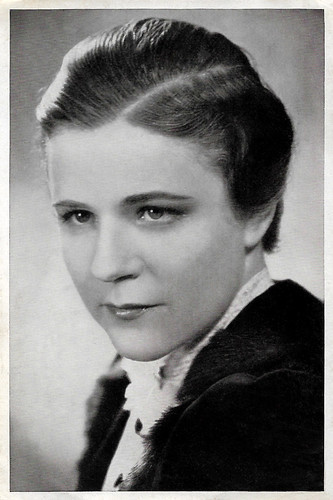
German collectors card in the series 'Vom Werden deutscher Filmkunst - Der Tonfilm', album no. 11, picture no. 103. Photo: Tobis-Sascha-Film / Ross Verlag. Paula Wessely in Maskerade/Masquerade in Vienna (Willi Forst, 1934).
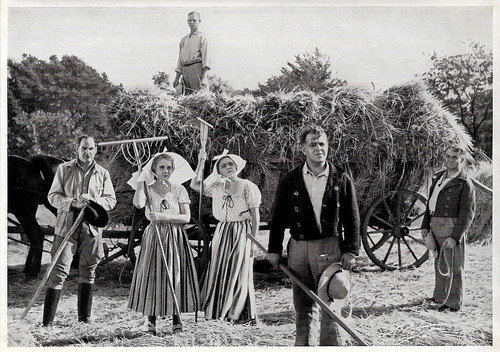
German collectors card in the series 'Vom Werden deutscher Filmkunst - Der Tonfilm', album no. 11, picture no. 105. Photo: Ufa / Ross Verlag. Hans Adalbert Schlettow , Cilly Feindt and Hermann Speelmans in Ferien von Ich/Vacation from me (Hans Deppe, 1934).
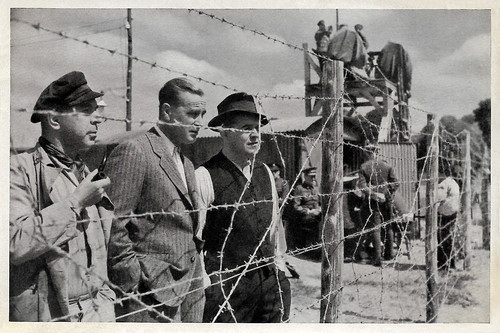
German collectors card in the series 'Vom Werden deutscher Filmkunst - Der Tonfilm', album no. 11, picture no. 107. Photo: Ufa / Ross Verlag. Willi Schur, Karl Ludwig Diehl and Hermann Speelmans in Ein Mann will nach Deutschland/A Man Wants to Get to Germany (Paul Wegener, 1934).
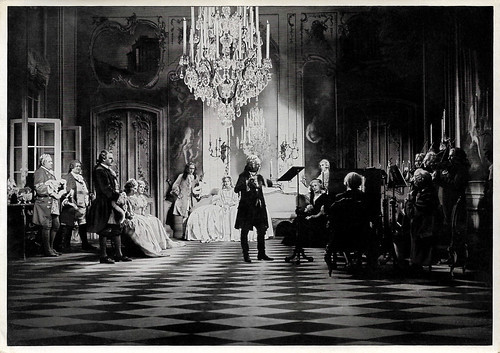
German collectors card in the series 'Vom Werden deutscher Filmkunst - Der Tonfilm', album no. 11, picture no. 109. Photo: Ufa / Ross Verlag. Otto Gebühr in Das Flötenkonzert von Sanssouci/The Flute Concert of Sans-Souci (Gustav Ucicky, 1930).
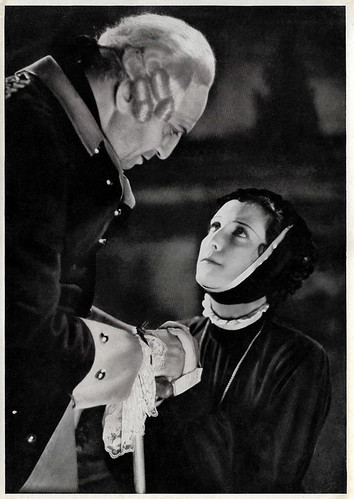
German collectors card in the series 'Vom Werden deutscher Filmkunst - Der Tonfilm', album no. 11, picture no. 112. Photo: Phoebus-Film / Ross Verlag. Theodor Loos and Dorothea Wieck in Trenck - Der Roman einer großen Liebe/Trenck (Ernst Neubach, Heinz Paul, 1932).
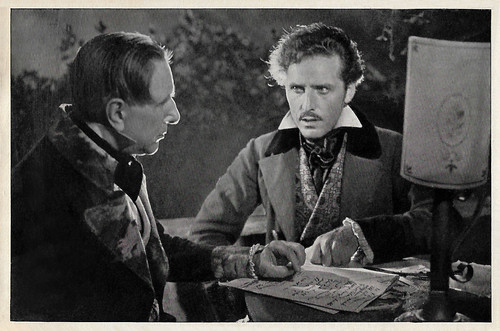
German collectors card in the series 'Vom Werden deutscher Filmkunst - Der Tonfilm', album no. 11, picture no. 116, Group 44. Photo: Aafa / Ross Verlag. Willi Domgraef Fassbaender in Theodor Körner (Carl Boese, 1932).
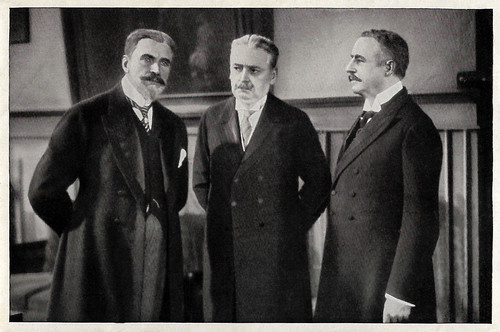
German collectors card in the series 'Vom Werden deutscher Filmkunst - Der Tonfilm', album no. 11, picture no. 118. Photo: Richard Oswald-Film / Ross Verlag. Albert Bassermann in 1914, die letzten Tage vor dem Weltbrand/1914: The Last Days Before the War (Richard Oswald, 1931).
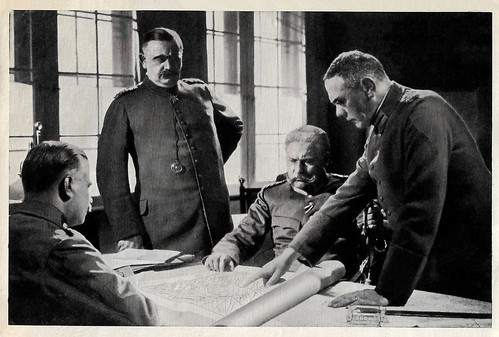
German collectors card in the series 'Vom Werden deutscher Filmkunst - Der Tonfilm', album no. 11, picture no. 120, group 44. Photo: H.P. Film der Praesenz / Ross Verlag. Karl Körner, Henry Pless and Hans Mühlhofer in Tannenberg (Heinz Paul, 1932). Caption: Lüdendorf, Hindenburg und Oberleutnant Hoffmann in dem Film Tannenberg, dargestellt van Schauspielern. (Lüdendorf, Hindenburg and senior lieutenant Hoffmann in the film Tannenberg, played by actors.)
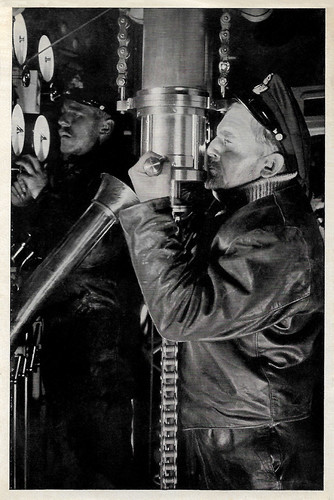
German collectors card in the series 'Vom Werden deutscher Filmkunst - Der Tonfilm', album no. 11, image no. 123. Photo: Ufa / Ross Verlag. Rudolf Forster in Morgenrot/Dawn (Vernon Sewell, Gustav Ucicky, 1933).
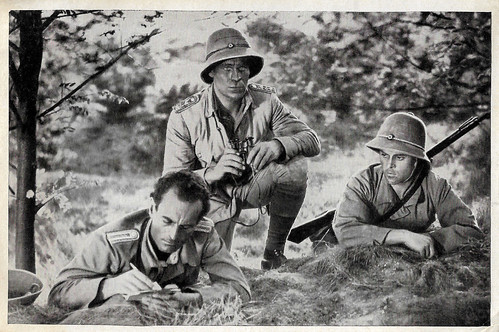
German collectors card in the series 'Vom Werden deutscher Filmkunst - Der Tonfilm', album no. 11, picture no. 124. Photo: Terra-Film / Ross Verlag. Sepp Rist in Die Reiter von Deutsch-Ostafrika/The Riders of German East Africa (Herbert Selpin, 1934).
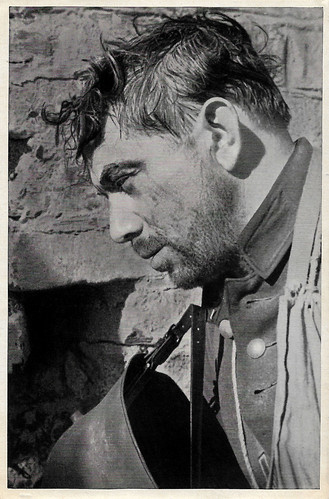
German collectors card in the series 'Vom Werden deutscher Filmkunst - Der Tonfilm', album no. 11, picture no. 126, group 44. Photo: Arya Film / Ross Verlag. Ludwig Schmid-Wildy in Stoßtrupp 1917/Shock Troop (Ludwig Schmid-Wildy, Hans Zöberlein, 1934).
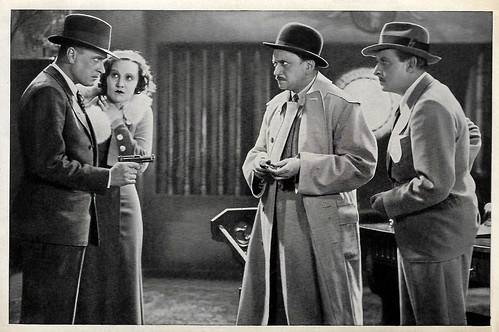
German collectors card in the series 'Vom Werden deutscher Filmkunst - Der Tonfilm', album no. 11, picture no. 129, group 44. Photo: Ufa / Ross Verlag. Karl Ludwig Diehl , Ery Bos , Theodor Loos and Fritz Odemar in Schuss im Morgengrauen/A Shot at Dawn (Alfred Zeisler, 1932).
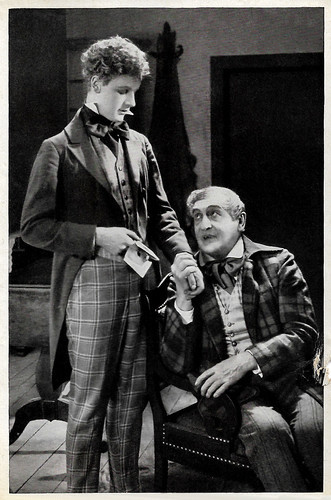
German collectors card in the series 'Vom Werden deutscher Filmkunst - Der Tonfilm', album no. 11, picture no. 130. Photo: Ufa / Ross Verlag. Walter Slezak and Hans Mierendorff in Mein Leopold/My Leopold (Hans Steinhoff, 1931).
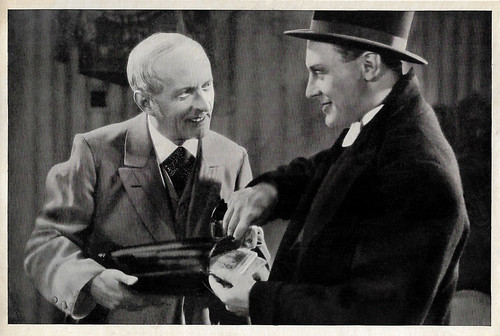
German collectors card in the series 'Vom Werden deutscher Filmkunst - Der Tonfilm', album no. 11, picture no. 131. Photo: Messtro-Film / Ross Verlag. Max Adalbert and Harald Paulsen in Mein Leopold/My Leopold (Hans Steinhoff, 1931).
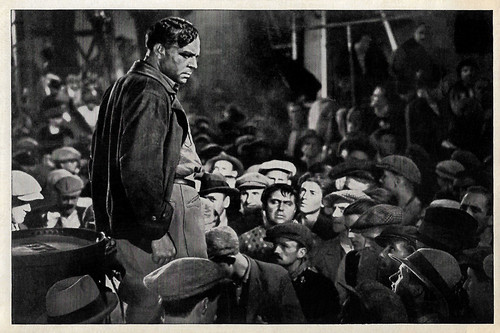
German collectors card in the series 'Vom Werden deutscher Filmkunst - Der Tonfilm', album no. 11, picture no. 132, group 44. Photo: Bayerische Filmges. / Ross Verlag. Paul Hartmann in Der Tunnel/The Tunnel (Kurt Bernhardt, 1931).
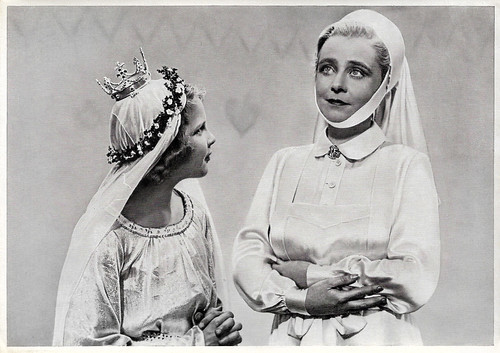
German collectors card in the series 'Vom Werden deutscher Filmkunst - Der Tonfilm', album no. 11, picture no. 135. Photo: Aafa / Ross Verlag. Inge Landgut and Käthe Haack in Hanneles Himmelfahrt/Hannele's Ascension (Thea von Harbou, 1934).
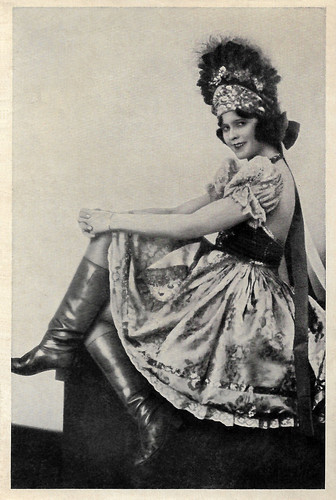
German collectors card in the series 'Vom Werden deutscher Filmkunst - Der Tonfilm', album no. 11, picture no. 136, Group 44. Photo: Ufa / Ross Verlag. Liane Haid in Die Csardasfürstin/The Csardas Princess (Hanns Schwarz, 1927).
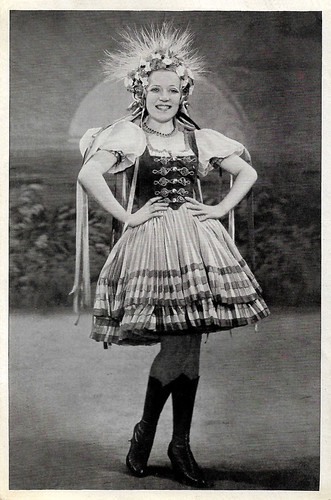
German collectors card in the series 'Vom Werden deutscher Filmkunst - Der Tonfilm', album no. 11, picture no. 137. Photo: Ufa / Ross Verlag. Marta Eggerth in Die Czardasfürstin/The Csardas Princess (Georg Jacoby, 1934).
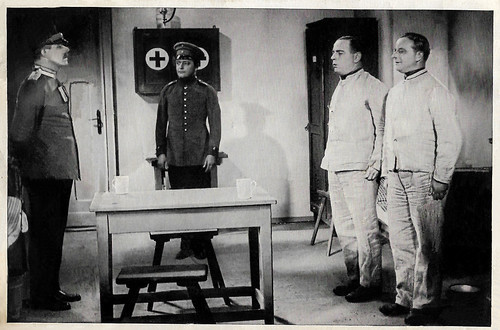
German collectors card in the series 'Vom Werden deutscher Filmkunst - Der Tonfilm', album no. 11, picture no. 139, group 44. Photo: Ufa / Ross Verlag. Fritz Schulz and Paul Heidemann in Dienst ist Dienst/Duty is Duty (Carl Boese, 1931).
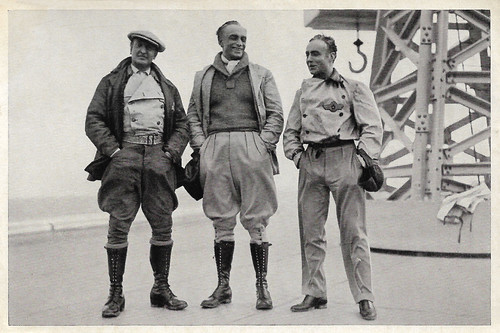
German collectors card in the series 'Vom Werden deutscher Filmkunst - Der Tonfilm', album no. 11, picture no. 141. Photo: Ufa / Ross Verlag. Hans Albers , Conrad Veidt and Charles Boyer , the stars of the German, English and French versions of F.P.1 antwortet nicht/F.P.1 Doesn't Answer (Karl Hartl, 1932).
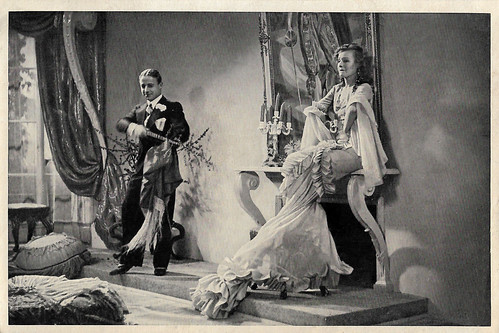
German collectors card in the series 'Vom Werden deutscher Filmkunst - Der Tonfilm', album no. 11, picture no. 142, group 44. Photo: Ufa / Ross Verlag. Heinz Rühmann and Lilian Harvey in the German version of Einbrecher/Burglars (Hanns Schwarz, 1930).
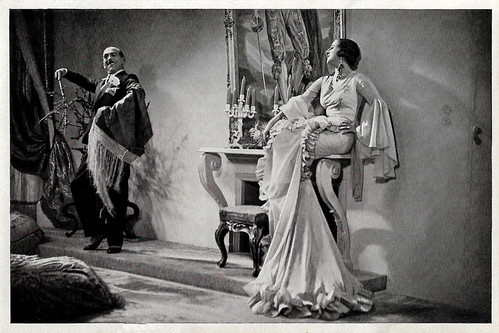
German collectors card in the series 'Vom Werden deutscher Filmkunst - Der Tonfilm', album no. 11, picture no. 143. Photo: Ufa / Ross Verlag. Blanche Montel and Charles Dechamps in Flagrant délit (Hanns Schwarz, Georges Tréville, 1931), the alternate version of Einbrecher/Burglars (Hanns Schwarz, 1930). Caption: "Dieselbe Szene der französischen Fassung mit französischen Darstellern in der deutschen Decoration." (The same scene from the French version with French actors in the German sets.)
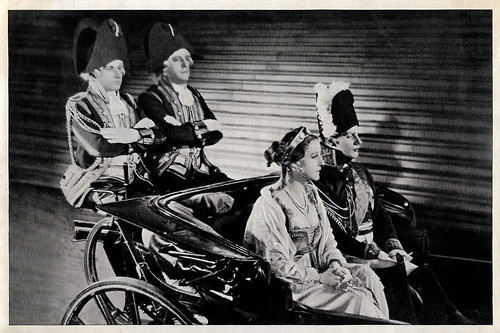
German collectors card in the series 'Vom Werden deutscher Filmkunst - Der Tonfilm', album no. 11, picture no. 146, group 44. Photo: Nero-Porten-Film / Ross Verlag. Henny Porten and Gustaf Gründgens in Luise, Königin von Preußen/Luise, Queen of Prussia (Carl Froelich, 1931).
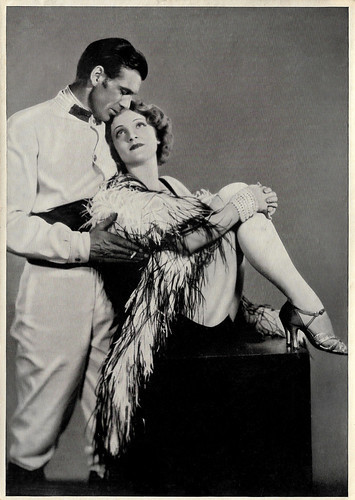
German collectors card in the series 'Vom Werden deutscher Filmkunst - Der Tonfilm', album no. 11, picture no. 149. Photo: Paramount / Ross Verlag. Gary Cooper and Marlene Dietrich in Morocco (Herzen in Flammen) (Josef von Sternberg, 1930).
To be continued.

German collectors card in the series 'Vom Werden deutscher Filmkunst - Der Tonfilm', album no. 11, picture no. 103. Photo: Tobis-Sascha-Film / Ross Verlag. Paula Wessely in Maskerade/Masquerade in Vienna (Willi Forst, 1934).

German collectors card in the series 'Vom Werden deutscher Filmkunst - Der Tonfilm', album no. 11, picture no. 105. Photo: Ufa / Ross Verlag. Hans Adalbert Schlettow , Cilly Feindt and Hermann Speelmans in Ferien von Ich/Vacation from me (Hans Deppe, 1934).

German collectors card in the series 'Vom Werden deutscher Filmkunst - Der Tonfilm', album no. 11, picture no. 107. Photo: Ufa / Ross Verlag. Willi Schur, Karl Ludwig Diehl and Hermann Speelmans in Ein Mann will nach Deutschland/A Man Wants to Get to Germany (Paul Wegener, 1934).

German collectors card in the series 'Vom Werden deutscher Filmkunst - Der Tonfilm', album no. 11, picture no. 109. Photo: Ufa / Ross Verlag. Otto Gebühr in Das Flötenkonzert von Sanssouci/The Flute Concert of Sans-Souci (Gustav Ucicky, 1930).

German collectors card in the series 'Vom Werden deutscher Filmkunst - Der Tonfilm', album no. 11, picture no. 112. Photo: Phoebus-Film / Ross Verlag. Theodor Loos and Dorothea Wieck in Trenck - Der Roman einer großen Liebe/Trenck (Ernst Neubach, Heinz Paul, 1932).

German collectors card in the series 'Vom Werden deutscher Filmkunst - Der Tonfilm', album no. 11, picture no. 116, Group 44. Photo: Aafa / Ross Verlag. Willi Domgraef Fassbaender in Theodor Körner (Carl Boese, 1932).

German collectors card in the series 'Vom Werden deutscher Filmkunst - Der Tonfilm', album no. 11, picture no. 118. Photo: Richard Oswald-Film / Ross Verlag. Albert Bassermann in 1914, die letzten Tage vor dem Weltbrand/1914: The Last Days Before the War (Richard Oswald, 1931).

German collectors card in the series 'Vom Werden deutscher Filmkunst - Der Tonfilm', album no. 11, picture no. 120, group 44. Photo: H.P. Film der Praesenz / Ross Verlag. Karl Körner, Henry Pless and Hans Mühlhofer in Tannenberg (Heinz Paul, 1932). Caption: Lüdendorf, Hindenburg und Oberleutnant Hoffmann in dem Film Tannenberg, dargestellt van Schauspielern. (Lüdendorf, Hindenburg and senior lieutenant Hoffmann in the film Tannenberg, played by actors.)

German collectors card in the series 'Vom Werden deutscher Filmkunst - Der Tonfilm', album no. 11, image no. 123. Photo: Ufa / Ross Verlag. Rudolf Forster in Morgenrot/Dawn (Vernon Sewell, Gustav Ucicky, 1933).

German collectors card in the series 'Vom Werden deutscher Filmkunst - Der Tonfilm', album no. 11, picture no. 124. Photo: Terra-Film / Ross Verlag. Sepp Rist in Die Reiter von Deutsch-Ostafrika/The Riders of German East Africa (Herbert Selpin, 1934).

German collectors card in the series 'Vom Werden deutscher Filmkunst - Der Tonfilm', album no. 11, picture no. 126, group 44. Photo: Arya Film / Ross Verlag. Ludwig Schmid-Wildy in Stoßtrupp 1917/Shock Troop (Ludwig Schmid-Wildy, Hans Zöberlein, 1934).

German collectors card in the series 'Vom Werden deutscher Filmkunst - Der Tonfilm', album no. 11, picture no. 129, group 44. Photo: Ufa / Ross Verlag. Karl Ludwig Diehl , Ery Bos , Theodor Loos and Fritz Odemar in Schuss im Morgengrauen/A Shot at Dawn (Alfred Zeisler, 1932).

German collectors card in the series 'Vom Werden deutscher Filmkunst - Der Tonfilm', album no. 11, picture no. 130. Photo: Ufa / Ross Verlag. Walter Slezak and Hans Mierendorff in Mein Leopold/My Leopold (Hans Steinhoff, 1931).

German collectors card in the series 'Vom Werden deutscher Filmkunst - Der Tonfilm', album no. 11, picture no. 131. Photo: Messtro-Film / Ross Verlag. Max Adalbert and Harald Paulsen in Mein Leopold/My Leopold (Hans Steinhoff, 1931).

German collectors card in the series 'Vom Werden deutscher Filmkunst - Der Tonfilm', album no. 11, picture no. 132, group 44. Photo: Bayerische Filmges. / Ross Verlag. Paul Hartmann in Der Tunnel/The Tunnel (Kurt Bernhardt, 1931).

German collectors card in the series 'Vom Werden deutscher Filmkunst - Der Tonfilm', album no. 11, picture no. 135. Photo: Aafa / Ross Verlag. Inge Landgut and Käthe Haack in Hanneles Himmelfahrt/Hannele's Ascension (Thea von Harbou, 1934).

German collectors card in the series 'Vom Werden deutscher Filmkunst - Der Tonfilm', album no. 11, picture no. 136, Group 44. Photo: Ufa / Ross Verlag. Liane Haid in Die Csardasfürstin/The Csardas Princess (Hanns Schwarz, 1927).

German collectors card in the series 'Vom Werden deutscher Filmkunst - Der Tonfilm', album no. 11, picture no. 137. Photo: Ufa / Ross Verlag. Marta Eggerth in Die Czardasfürstin/The Csardas Princess (Georg Jacoby, 1934).

German collectors card in the series 'Vom Werden deutscher Filmkunst - Der Tonfilm', album no. 11, picture no. 139, group 44. Photo: Ufa / Ross Verlag. Fritz Schulz and Paul Heidemann in Dienst ist Dienst/Duty is Duty (Carl Boese, 1931).

German collectors card in the series 'Vom Werden deutscher Filmkunst - Der Tonfilm', album no. 11, picture no. 141. Photo: Ufa / Ross Verlag. Hans Albers , Conrad Veidt and Charles Boyer , the stars of the German, English and French versions of F.P.1 antwortet nicht/F.P.1 Doesn't Answer (Karl Hartl, 1932).

German collectors card in the series 'Vom Werden deutscher Filmkunst - Der Tonfilm', album no. 11, picture no. 142, group 44. Photo: Ufa / Ross Verlag. Heinz Rühmann and Lilian Harvey in the German version of Einbrecher/Burglars (Hanns Schwarz, 1930).

German collectors card in the series 'Vom Werden deutscher Filmkunst - Der Tonfilm', album no. 11, picture no. 143. Photo: Ufa / Ross Verlag. Blanche Montel and Charles Dechamps in Flagrant délit (Hanns Schwarz, Georges Tréville, 1931), the alternate version of Einbrecher/Burglars (Hanns Schwarz, 1930). Caption: "Dieselbe Szene der französischen Fassung mit französischen Darstellern in der deutschen Decoration." (The same scene from the French version with French actors in the German sets.)

German collectors card in the series 'Vom Werden deutscher Filmkunst - Der Tonfilm', album no. 11, picture no. 146, group 44. Photo: Nero-Porten-Film / Ross Verlag. Henny Porten and Gustaf Gründgens in Luise, Königin von Preußen/Luise, Queen of Prussia (Carl Froelich, 1931).

German collectors card in the series 'Vom Werden deutscher Filmkunst - Der Tonfilm', album no. 11, picture no. 149. Photo: Paramount / Ross Verlag. Gary Cooper and Marlene Dietrich in Morocco (Herzen in Flammen) (Josef von Sternberg, 1930).
To be continued.
Published on March 28, 2020 22:00
March 27, 2020
Mirror, mirror
The use of mirrors has become established in films. It developed as a device in the European silent cinema in the 1910s to distinguish the new medium from theatre and to connect film more with painting. When mirrors are used for visual dialogues between off-screen and on-screen characters and for creating excitement and voyeurism in silent films, the offscreen other often enters the frame, although the central character does not. It then developed both in the regular and in the avant-garde cinema in the 1920s and early 1930s, particularly in Germany in the films by F.W. Murnau, G.W. Pabst, and Fritz Lang, but also in the French avant-garde films, especially in the films by Jean Cocteau. For this post, Ivo Blom selected postcards in which the mirror is an important and intriguing device in the picture.
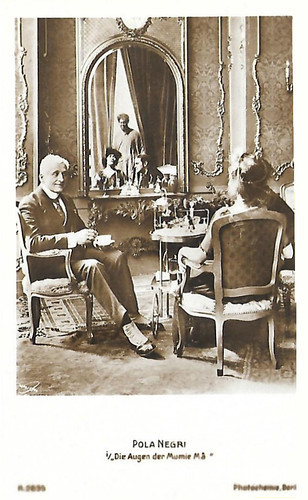
German postcard by Photochemie, Berlin, no. K. 2835. Photo: Union. Pola Negri in Die Augen der Mumie Ma/The Eyes of the Mummy (Ernst Lubitsch, 1918). Collection: Didier Hanson.
Polish film actress Pola Negri (1894-1987) achieved notoriety as a femme fatale in silent films between 1910s and 1930s.
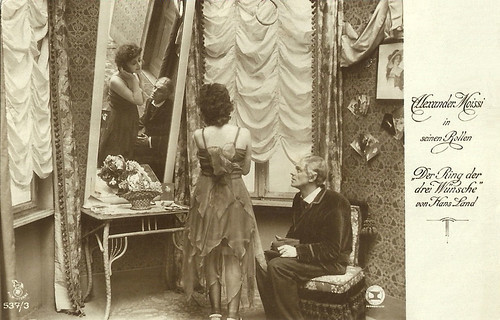
German postcard in the Film-Sterne sewries by Rotophot, no. 537/3. Photo: Amboss-Film, Dworsky Co. Alexander Moissi and Ria Jende in Der Ring der drei Wünsche (Arthur Wellin, 1918).
Albanian-Austrian Alexander Moissi (1879-1935) was one of the great European stage actors of the early-20th century. The attractive and charismatic women's idol also appeared in several silent and early sound films. German-Belgian actress Ria Jende (1898-?) was a star and producer of the silent German cinema. She appeared in 40 films before she married and retired.
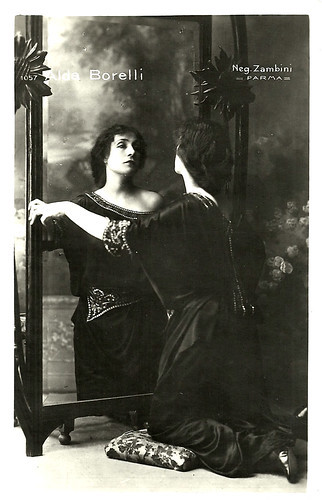
Italian postcard by Vettori, Bologna, no. 1057. Photo: Zambini, Parma.
Alda Borelli (1879-1964) was an Italian stage and screen actress, who peaked on stage in the 1920s, and also acted in a handful of silent films in the 1910s. She was the sister of Italian film diva Lyda Borelli .
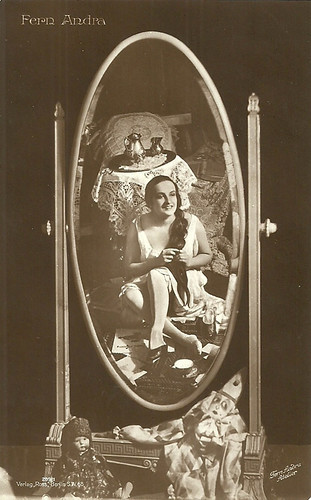
German postcard by Verlag Ross, no. 289/1. Photo: Fern Andra Atelier.
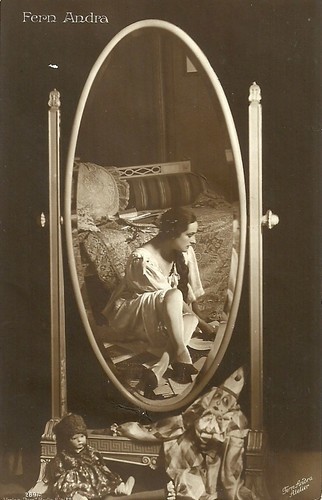
German postcard by Verlag Ross, no. 289/2. Photo: Fern Andra Atelier.
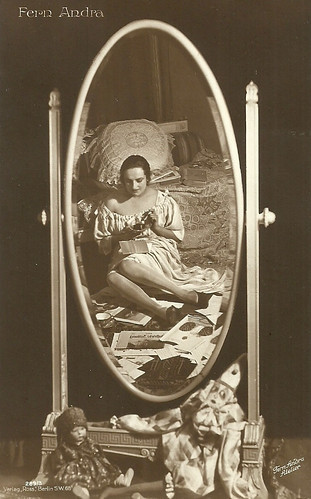
German postcard by Verlag Ross, no. 289/3. Photo: Fern Andra Atelier.
'Modern' American actress Fern Andra (1893-1974) became one of the most popular film stars of the German cinema in the 1910s and early 1920s. In her films she mastered tight roping, riding a horse without a saddle, driving cars and motorcycles, bobsleighing, and even boxing.
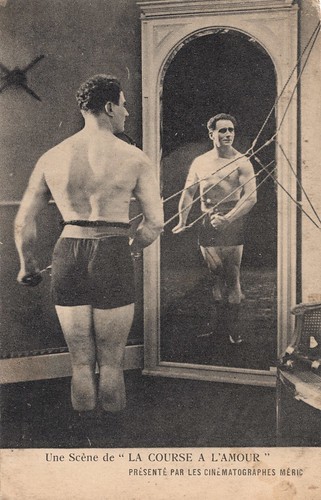
French postcard by Les Cinématographes Méric. Ausonia (Mario Guaita) in the French silent film La course à l'amour (Paul Barlatier, Charles Keppens, 1924).
Athletic muscleman Mario Guaita aka Ausonia (1881-1956) was an Italian actor, director, producer and scriptwriter in the silent era. He had his international breakthrough with Spartaco (Enrico Vidali 1913) and became a major actor in the Italian forzuto genre. In the early 1920s he moved to Marseille, made a few films there and ran a cinema.
The woman and her reflection
Of course, mirrors are often typical elements of film sets. People dress in front of mirrors, check their faces and clothes, comb their hair, shave, and apply or remove makeup.
But mirrors can also be used in narrative and metaphorical ways, such as emphasising a character’s introspection, showing his or her guilt or desire, providing passages to other worlds, and calling ghosts from the past or intimations of the future.
Mirrors embody a filmmaker’s preference for a more synthetic approach with deep staging and lengthy shots instead of analytical editing that fragments scenes and actors into several shots.
They also suggest that the film space does not stop at the frame’s borders, through incorporating off-screen space and off-screen characters. They add a dimension to the filmic space, showing parts that otherwise would remain hidden; they break the stage’s traditional fourth wall.
The woman and her reflection was a favourite motif in many films. These images were disseminated through postcards and illustrations in trade papers and fan magazines. They conveyed a positive, even seductive, image of a self-possessed woman who looks in the mirror or at the viewer, with the mirror often doubling or tripling the view by revealing her face, figure or legs.
Mirrors also emphasized the opulence of the setting as an asset; large mirrors were associated with luxurious decors. Theatrical promotions that placed actors in front of mirrors were also a popular motif.
Thus, in the twenties, the French magazine Comoedia issued a large series of postcards with stage actors photographed in their locker rooms entitled, ‘Nos artistes dans leur loge’. Invariably, the dressing room mirror was used to double the image - but also the status - of the actor or actress.
Luchino Visconti uses mirrors not only to show people confronting their inner selves but also other people. Someone stands onscreen, the other offscreen but appears onscreen through his or her reflection, talking to the on-screen character. Since characters talk to each other without the classical device of analytical editing (in which the camera alternates between characters and shows them in separate, closer shots), this alternative can be considered as a kind of interior editing: the unity of time, place, and action is maintained. We have a synthetic, rather than analytical, structure reminiscent of the theatre.
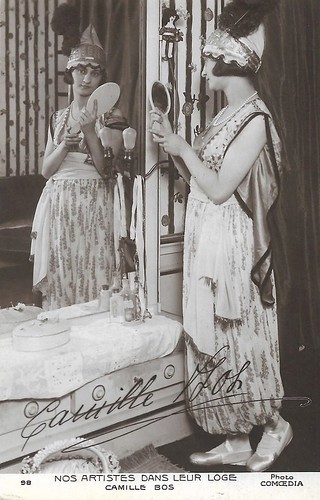
French postcard in the Nos artistes dans leur loge series, no. 98. Photo: Comoedia.
Camille Bos (born 1899) was a French ballet dancer. At the age of 10 (other sources say: 8), she entered the ballet school of the Paris Opera. In 1920 she was named 'première danseuse', and in 1925 she was promoted to 'danseuse étoile/ star dancer'. Bos participated in numerous performances e.g. 'Siang-Sin' (1927), 'L'écran des jeunes filles' (1929), 'La Grisi' (choreography by Albert d'Aveline, 1935), etc. Her partners were among the famous ones of those decades such as Serge Peretti and Serge Lifar with whom she danced in 'Le Spectre de la Rose' (1931) by Michel Fokine. At the age of 36 she stopped dancing to dedicate herself to teaching. For 12 years she taught at the Opéra de Paris. Her only known film performance was as a dancer in the Zola adaptation Nantas (Donatien, 1925) starring Donatien , Lucienne Legrand, and Maxime Desjardins . In 1935 she was recorded for an early television experiment.
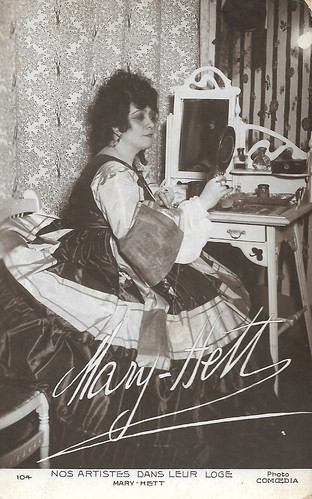
French postcard in the Series Nos artistes dans leur loge, no. 104. Photo: Comoedia.
Mary-Hett (?-?) was a French actress and operetta singer. Already around 1900, Mary Hett aka Mary-Hett was a popular Parisian café-concert singer and would remain so for decades.
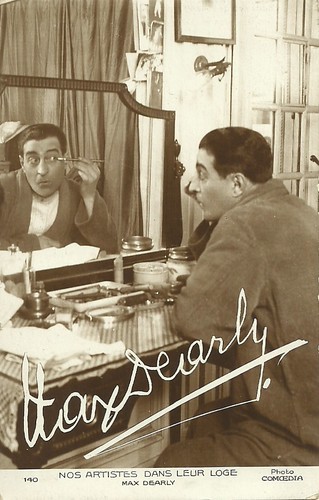
French postcard in the Nos artistes dans leur loge series by Editions La Fayette, Paris, no. 140. Photo: Comoedia.
Max Dearly (1874-1943) was a French actor, famous for his parts in 1930s French sound film but also for his previous career in Parisian vaudeville.
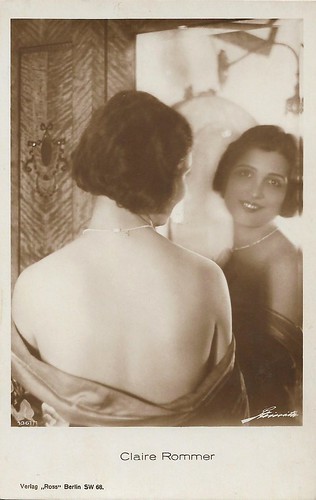
German postcard by Ross Verlag, no. 1361/1, 1927-1928. Photo: Alex Binder.
Elegant German actress Claire Rommer (1904-1996) appeared in about 50 German film productions during the 1920s and the early 1930s. Her successful career suddenly ended with the seizure of power by the Nazis.
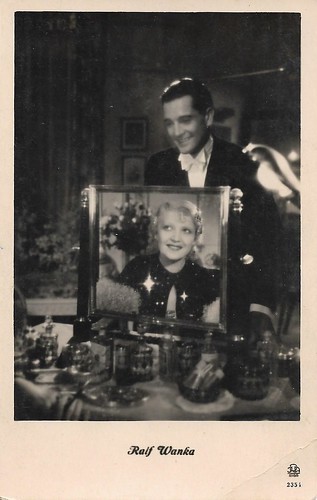
Latvian postcard by IRA, Riga, no. 2354. Rolf Wanka is misspelled as 'Ralf Wanka'. The lady in the reflection seems Martha Eggerth , so this could be for the film Die ganze Welt dreht sich um Liebe (Viktor Tourjansky, 1935), in which both starred.
Austrian actor Rolf Wanka (1901-1982) was a handsome, suave star of the European cinema of the 1930s and the 1950s. He often played supporting parts as well-dressed, dignified gentlemen, and appeared in more than 100 films and television shows between 1931 and 1976.
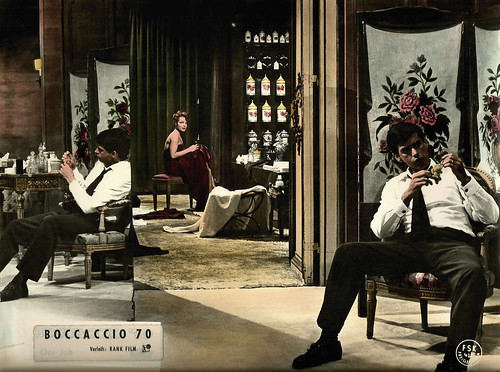
Publicity still used in Germany, distributed by Rank, mark of the German censor FSK. Thomas Milian & Romy Schneider in Luchino Visconti's episode Il Lavoro in the episode film Boccaccio 70 (1962).
Milian plays a bored aristocrat, caught in a scandal with callgirls. Schneider plays his rich and equally bored Austrian wife, who tries to seduce her husband and make him pay for love just like he did with his callgirls. It works but leaves the woman with bitterness. The set of the film was terribly costly because of all the authentic, valuable objects present.

Via Saraceno, Ferrare, Italy. Photo: Paul van Yperen.
In this street, scenes of Luchino Visconti's film debut Ossessione (1942) were filmed.
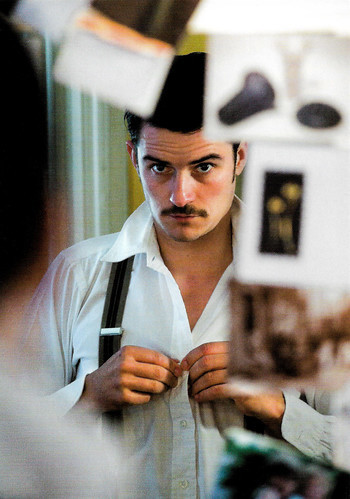
German postcard by Salz und Silber Verlag. Photo: Simon Annand. Caption: Orlando Bloom, Duke of York's Theatre, Celebration, 2007.
English actor Orlando Bloom (1977) made his breakthrough as Legolas in The Lord of the Rings film series and rose to fame as Will Turner in the Pirates of the Caribbean film series. He established himself as a leading man in Hollywood with roles such as Paris in Troy (2004) and Balian de Ibelin in Kingdom of Heaven (2005). He later reprised his role as Legolas in The Hobbit film series and currently stars in the series Carnival Row (2019–present).
Source: Ivo Blom, Reframing Luchino Visconti: Film and Art (Leiden: Sidestone Press, 2018).

German postcard by Photochemie, Berlin, no. K. 2835. Photo: Union. Pola Negri in Die Augen der Mumie Ma/The Eyes of the Mummy (Ernst Lubitsch, 1918). Collection: Didier Hanson.
Polish film actress Pola Negri (1894-1987) achieved notoriety as a femme fatale in silent films between 1910s and 1930s.

German postcard in the Film-Sterne sewries by Rotophot, no. 537/3. Photo: Amboss-Film, Dworsky Co. Alexander Moissi and Ria Jende in Der Ring der drei Wünsche (Arthur Wellin, 1918).
Albanian-Austrian Alexander Moissi (1879-1935) was one of the great European stage actors of the early-20th century. The attractive and charismatic women's idol also appeared in several silent and early sound films. German-Belgian actress Ria Jende (1898-?) was a star and producer of the silent German cinema. She appeared in 40 films before she married and retired.

Italian postcard by Vettori, Bologna, no. 1057. Photo: Zambini, Parma.
Alda Borelli (1879-1964) was an Italian stage and screen actress, who peaked on stage in the 1920s, and also acted in a handful of silent films in the 1910s. She was the sister of Italian film diva Lyda Borelli .

German postcard by Verlag Ross, no. 289/1. Photo: Fern Andra Atelier.

German postcard by Verlag Ross, no. 289/2. Photo: Fern Andra Atelier.

German postcard by Verlag Ross, no. 289/3. Photo: Fern Andra Atelier.
'Modern' American actress Fern Andra (1893-1974) became one of the most popular film stars of the German cinema in the 1910s and early 1920s. In her films she mastered tight roping, riding a horse without a saddle, driving cars and motorcycles, bobsleighing, and even boxing.

French postcard by Les Cinématographes Méric. Ausonia (Mario Guaita) in the French silent film La course à l'amour (Paul Barlatier, Charles Keppens, 1924).
Athletic muscleman Mario Guaita aka Ausonia (1881-1956) was an Italian actor, director, producer and scriptwriter in the silent era. He had his international breakthrough with Spartaco (Enrico Vidali 1913) and became a major actor in the Italian forzuto genre. In the early 1920s he moved to Marseille, made a few films there and ran a cinema.
The woman and her reflection
Of course, mirrors are often typical elements of film sets. People dress in front of mirrors, check their faces and clothes, comb their hair, shave, and apply or remove makeup.
But mirrors can also be used in narrative and metaphorical ways, such as emphasising a character’s introspection, showing his or her guilt or desire, providing passages to other worlds, and calling ghosts from the past or intimations of the future.
Mirrors embody a filmmaker’s preference for a more synthetic approach with deep staging and lengthy shots instead of analytical editing that fragments scenes and actors into several shots.
They also suggest that the film space does not stop at the frame’s borders, through incorporating off-screen space and off-screen characters. They add a dimension to the filmic space, showing parts that otherwise would remain hidden; they break the stage’s traditional fourth wall.
The woman and her reflection was a favourite motif in many films. These images were disseminated through postcards and illustrations in trade papers and fan magazines. They conveyed a positive, even seductive, image of a self-possessed woman who looks in the mirror or at the viewer, with the mirror often doubling or tripling the view by revealing her face, figure or legs.
Mirrors also emphasized the opulence of the setting as an asset; large mirrors were associated with luxurious decors. Theatrical promotions that placed actors in front of mirrors were also a popular motif.
Thus, in the twenties, the French magazine Comoedia issued a large series of postcards with stage actors photographed in their locker rooms entitled, ‘Nos artistes dans leur loge’. Invariably, the dressing room mirror was used to double the image - but also the status - of the actor or actress.
Luchino Visconti uses mirrors not only to show people confronting their inner selves but also other people. Someone stands onscreen, the other offscreen but appears onscreen through his or her reflection, talking to the on-screen character. Since characters talk to each other without the classical device of analytical editing (in which the camera alternates between characters and shows them in separate, closer shots), this alternative can be considered as a kind of interior editing: the unity of time, place, and action is maintained. We have a synthetic, rather than analytical, structure reminiscent of the theatre.

French postcard in the Nos artistes dans leur loge series, no. 98. Photo: Comoedia.
Camille Bos (born 1899) was a French ballet dancer. At the age of 10 (other sources say: 8), she entered the ballet school of the Paris Opera. In 1920 she was named 'première danseuse', and in 1925 she was promoted to 'danseuse étoile/ star dancer'. Bos participated in numerous performances e.g. 'Siang-Sin' (1927), 'L'écran des jeunes filles' (1929), 'La Grisi' (choreography by Albert d'Aveline, 1935), etc. Her partners were among the famous ones of those decades such as Serge Peretti and Serge Lifar with whom she danced in 'Le Spectre de la Rose' (1931) by Michel Fokine. At the age of 36 she stopped dancing to dedicate herself to teaching. For 12 years she taught at the Opéra de Paris. Her only known film performance was as a dancer in the Zola adaptation Nantas (Donatien, 1925) starring Donatien , Lucienne Legrand, and Maxime Desjardins . In 1935 she was recorded for an early television experiment.

French postcard in the Series Nos artistes dans leur loge, no. 104. Photo: Comoedia.
Mary-Hett (?-?) was a French actress and operetta singer. Already around 1900, Mary Hett aka Mary-Hett was a popular Parisian café-concert singer and would remain so for decades.

French postcard in the Nos artistes dans leur loge series by Editions La Fayette, Paris, no. 140. Photo: Comoedia.
Max Dearly (1874-1943) was a French actor, famous for his parts in 1930s French sound film but also for his previous career in Parisian vaudeville.

German postcard by Ross Verlag, no. 1361/1, 1927-1928. Photo: Alex Binder.
Elegant German actress Claire Rommer (1904-1996) appeared in about 50 German film productions during the 1920s and the early 1930s. Her successful career suddenly ended with the seizure of power by the Nazis.

Latvian postcard by IRA, Riga, no. 2354. Rolf Wanka is misspelled as 'Ralf Wanka'. The lady in the reflection seems Martha Eggerth , so this could be for the film Die ganze Welt dreht sich um Liebe (Viktor Tourjansky, 1935), in which both starred.
Austrian actor Rolf Wanka (1901-1982) was a handsome, suave star of the European cinema of the 1930s and the 1950s. He often played supporting parts as well-dressed, dignified gentlemen, and appeared in more than 100 films and television shows between 1931 and 1976.

Publicity still used in Germany, distributed by Rank, mark of the German censor FSK. Thomas Milian & Romy Schneider in Luchino Visconti's episode Il Lavoro in the episode film Boccaccio 70 (1962).
Milian plays a bored aristocrat, caught in a scandal with callgirls. Schneider plays his rich and equally bored Austrian wife, who tries to seduce her husband and make him pay for love just like he did with his callgirls. It works but leaves the woman with bitterness. The set of the film was terribly costly because of all the authentic, valuable objects present.

Via Saraceno, Ferrare, Italy. Photo: Paul van Yperen.
In this street, scenes of Luchino Visconti's film debut Ossessione (1942) were filmed.

German postcard by Salz und Silber Verlag. Photo: Simon Annand. Caption: Orlando Bloom, Duke of York's Theatre, Celebration, 2007.
English actor Orlando Bloom (1977) made his breakthrough as Legolas in The Lord of the Rings film series and rose to fame as Will Turner in the Pirates of the Caribbean film series. He established himself as a leading man in Hollywood with roles such as Paris in Troy (2004) and Balian de Ibelin in Kingdom of Heaven (2005). He later reprised his role as Legolas in The Hobbit film series and currently stars in the series Carnival Row (2019–present).
Source: Ivo Blom, Reframing Luchino Visconti: Film and Art (Leiden: Sidestone Press, 2018).
Published on March 27, 2020 23:00
Paul van Yperen's Blog
- Paul van Yperen's profile
- 13 followers
Paul van Yperen isn't a Goodreads Author
(yet),
but they
do have a blog,
so here are some recent posts imported from
their feed.



